Artificial Neural Network-Based Residential Energy Consumption Prediction Models Considering Residential Building Information and User Features in South Korea
Abstract
1. Introduction
2. Literature Review
2.1. Effects of Physical Building Characteristics on Energy Consumption
2.2. Effects of User Sociology on Energy Consumption
3. Materials and Methods
3.1. Household Energy Standing Survey Data
3.2. Seasonal Characteristics in South Korea and their Effects on Energy Consumption
3.3. Derivation of Significant Elements through Multiple Regression Analysis
3.4. Prediction of Energy Consumption Using ANNs
4. Results and Discussion
4.1. Derivation of Influential Elements
4.1.1. Analysis Process (Multi-Collinearity, Outliers, and Dependent and Independent Variables)
4.1.2. Elements Affecting Energy Consumption
4.2. Energy Consumption Prediction Model
4.2.1. Input/Output Data
4.2.2. Hidden Layer and Node
4.2.3. ANN Simulation Result
5. Conclusions
- In spring, the building direction was found to be the most influential element, followed by the occupation and cooling method. Buildings facing northwest—the direction with the lowest annual average solar radiation—exhibited the highest energy consumption. Buildings inhabited by to business owners, who typically have longer residence times than other occupations, also consumed more energy. Households that used air conditioners for cooling consumed more energy.
- In summer, the heating method was the most influential, followed by the cooling method and housing area. For residential buildings in South Korea, individual heating and central heating are the two representative heating methods. Households with individual heating were found to consume more energy. Heating energy was mostly concentrated on the use of hot water in summer, indicating that individual heating was more vulnerable to the use of energy related to hot water. As in spring, households that used air conditioners consumed more energy, as did households with larger areas.
- In fall, the housing area was the most influential factor, followed by the housing type and occupation. Households with larger areas consumed more energy, as did detached houses that managed energy individually. As in spring, buildings inhabited by to business owners exhibited the highest energy consumption.
- In winter, the building direction was the most influential, followed by the housing area and occupation. As in spring, the northwest direction with the lowest solar radiation exhibited the highest energy consumption. As the housing area increased, energy consumption increased. As for the occupation, to business owners with the longest residence time exhibited the highest energy consumption, as in spring and fall.
Author Contributions
Funding
Conflicts of Interest
Appendix A
| Annual | Spring | |||||||||
|---|---|---|---|---|---|---|---|---|---|---|
| Unstandardized Coefficient | Standardized Coefficient | t | p | Unstandardized Coefficient | Standardized Coefficient | t | p | |||
| B | Standard Error | B | Standard Error | |||||||
| item | 0.357 | 20.728 | 00.000 | 00.017 | 0.986 | 430.039 | 14.879 | 00.051 | 2.893 | *** 00.004 |
| cityD2 | −1814.663 | 364.398 | −00.080 | −4.980 | *** 00.000 | −907.482 | 113.356 | −0.128 | −80.006 | *** 00.000 |
| cityD3 | −1016.515 | 400.446 | −00.039 | −2.538 | ** 00.011 | −391.367 | 126.351 | −00.048 | −30.097 | *** 00.002 |
| cityD4 | 814.586 | 400.820 | 00.031 | 20.032 | ** 00.042 | 308.361 | 127.427 | 00.038 | 2.420 | ** 00.016 |
| cityD5 | −11310.071 | 4070.010 | −00.043 | −2.779 | *** 00.005 | −741.729 | 126.291 | −00.090 | −5.873 | *** 00.000 |
| cityD6 | −7080.094 | 398.812 | −00.027 | −1.776 | * 00.076 | −300.561 | 124.220 | −00.036 | −2.420 | ** 00.016 |
| cityD7 | 433.798 | 469.603 | 00.014 | 0.924 | 0.356 | −83.532 | 145.999 | −00.008 | −0.572 | 0.567 |
| cityD8 | 291.769 | 302.461 | 00.016 | 0.965 | 0.335 | −830.080 | 94.586 | −00.015 | −0.878 | 0.380 |
| cityD9 | 2138.199 | 412.616 | 00.081 | 5.182 | *** 00.000 | 219.506 | 129.448 | 00.027 | 1.696 | * 0.090 |
| cityD10 | −1339.813 | 419.101 | −00.050 | −3.197 | *** 00.001 | −508.758 | 130.348 | −00.061 | −3.903 | *** 00.000 |
| cityD11 | −40.925 | 376.899 | −00.002 | −0.109 | 0.914 | −509.335 | 124.624 | −00.071 | −40.087 | *** 00.000 |
| cityD12 | 271.929 | 4190.089 | 00.010 | 0.649 | 0.516 | −376.520 | 138.285 | −00.046 | −2.723 | *** 00.006 |
| cityD13 | −9540.095 | 3770.056 | −00.041 | −2.530 | 00.011 | −805.814 | 119.814 | −0.112 | −6.726 | *** 00.000 |
| cityD14 | −260.189 | 346.897 | −00.013 | −0.750 | 0.453 | −297.113 | 109.483 | −00.046 | −2.714 | *** 00.007 |
| cityD15 | −1647.383 | 348.892 | −00.080 | −4.722 | *** 00.000 | −751.381 | 109.655 | −0.117 | −6.852 | *** 00.000 |
| cityD16 | −30600.076 | 655.856 | −00.067 | −4.666 | *** 00.000 | −1345.139 | 202.957 | −00.094 | −6.628 | *** 00.000 |
| B_a1D1 | 732.460 | 244.133 | 00.064 | 30.000 | *** 00.003 | 76.721 | 75.923 | 00.021 | 10.011 | 0.312 |
| B_a1D2 | −734.310 | 317.726 | −00.065 | −2.311 | ** 00.021 | 117.963 | 98.802 | 00.034 | 1.194 | 0.233 |
| B_a2 | 33.173 | 22.561 | 00.046 | 1.470 | 0.142 | 2.494 | 70.016 | 00.011 | .356 | 0.722 |
| B_a3 | −12.186 | 22.855 | −00.011 | −0.533 | 0.594 | −3.610 | 7.105 | −00.010 | −0.508 | 0.611 |
| B_a4 | 269.490 | 77.128 | 00.061 | 3.494 | *** 00.000 | 81.979 | 240.000 | 00.060 | 3.416 | *** 00.001 |
| B_a5D1 | −308.573 | 421.521 | −00.018 | −0.732 | 0.464 | −156.118 | 1310.077 | −00.029 | −1.191 | 0.234 |
| B_a5D2 | 173.711 | 4700.051 | 00.008 | 0.370 | 0.712 | 51.469 | 146.164 | 00.007 | 0.352 | 0.725 |
| B_a5D3 | −825.806 | 378.932 | −00.073 | −2.179 | ** 00.029 | −243.738 | 117.820 | −00.069 | −20.069 | ** 0.039 |
| B_a5D4 | −577.103 | 3980.033 | −00.041 | −1.450 | 0.147 | −1270.065 | 123.751 | −00.029 | −10.027 | 0.305 |
| B_a5D5 | −353.640 | 431.583 | −00.019 | −0.819 | 0.413 | −87.611 | 134.185 | −00.015 | −0.653 | 0.514 |
| B_a5D6 | 35.501 | 564.874 | 00.001 | 00.063 | 0.950 | −42.340 | 175.641 | −00.004 | −0.241 | 0.810 |
| B_a5D7 | 27400.077 | 660.559 | 00.067 | 4.148 | *** 00.000 | 798.281 | 205.397 | 00.062 | 3.887 | *** 00.000 |
| B_a6 | −64.802 | 74.977 | −00.015 | −0.864 | 0.387 | 53.711 | 23.309 | 00.040 | 2.304 | ** 00.021 |
| B_a7 | 617.644 | 135.289 | 00.096 | 4.565 | *** 00.000 | 1800.037 | 420.047 | 00.089 | 4.282 | *** 00.000 |
| B_a8 | 124.599 | 147.855 | 00.016 | 0.843 | 0.399 | 48.553 | 45.975 | 00.020 | 10.056 | 0.291 |
| B_a9 | 50.639 | 22.108 | 00.036 | 2.291 | ** 00.022 | 10.929 | 6.854 | 00.025 | 1.595 | 0.111 |
| H_a2 | 146.845 | 193.209 | 00.011 | 0.760 | 0.447 | −0.575 | 600.077 | 00.000 | −0.010 | 0.992 |
| H_a1 | 81.183 | 21.999 | 0.126 | 3.690 | *** 00.000 | 31.475 | 6.839 | 0.157 | 4.602 | *** 00.000 |
| H_a1′ | −0.747 | .495 | −00.050 | −1.509 | 0.131 | −0.435 | 0.154 | −00.094 | −2.823 | *** 00.005 |
| B_a10D1 | 171.356 | 295.268 | 00.009 | 0.580 | 0.562 | 393.854 | 91.814 | 00.065 | 4.290 | *** 00.000 |
| B_a11D1 | −6680.002 | 385.133 | −00.055 | −1.734 | * 00.083 | −127.971 | 110.536 | −00.034 | −1.158 | 0.247 |
| B_a12 | 6.388 | 91.652 | 00.002 | 00.070 | 0.944 | 2.708 | 25.294 | 00.003 | 0.107 | 0.915 |
| H_a3 | 462.611 | 86.738 | 0.103 | 5.333 | *** 00.000 | 132.854 | 26.966 | 00.094 | 4.927 | *** 00.000 |
| H_a4 | −44.999 | 124.266 | −00.006 | −0.362 | 0.717 | −31.374 | 38.633 | −00.014 | −0.812 | 0.417 |
| H_a5 | −28.372 | 135.552 | −00.004 | −0.209 | 0.834 | −39.405 | 42.151 | −00.017 | −0.935 | 0.350 |
| H_a6D1 | −29.574 | 396.759 | −00.001 | −00.075 | 0.941 | 70.830 | 123.367 | 00.009 | 0.574 | 0.566 |
| H_a7D1 | 341.354 | 201.582 | 00.026 | 1.693 | * 00.090 | 15.726 | 62.698 | 00.004 | 0.251 | 0.802 |
| H_a8 | 1570.023 | 102.477 | 00.029 | 1.532 | 0.126 | 220.078 | 31.828 | 00.013 | 0.694 | 0.488 |
| H−a9D1 | −255.470 | 193.122 | −00.022 | −1.323 | 0.186 | −78.738 | 600.050 | −00.022 | −1.311 | 0.190 |
| H_a10D1 | 211.767 | 250.475 | 00.019 | 0.845 | 0.398 | 52.686 | 77.883 | 00.015 | 0.676 | 0.499 |
| H_a10D2 | 4670.059 | 3730.087 | 00.019 | 1.252 | 0.211 | 126.967 | 1160.006 | 00.017 | 10.094 | 0.274 |
| H_a10D3 | 762.147 | 262.911 | 00.057 | 2.899 | *** 00.004 | 156.110 | 81.754 | 00.038 | 1.910 | * 00.056 |
| H_a11D1 | −430.564 | 317.554 | −00.023 | −1.356 | 0.175 | −143.325 | 98.641 | −00.024 | −1.453 | 0.146 |
| H_a12 | 192.451 | 61.871 | 00.064 | 3.111 | *** 00.002 | 53.379 | 19.237 | 00.057 | 2.775 | *** 00.006 |
| Summer | Fall | |||||||||
|---|---|---|---|---|---|---|---|---|---|---|
| Unstandardized Coefficient | Standardized Coefficient | t | p | Unstandardized Coefficient | Standardized Coefficient | t | p | |||
| B | Standard Error | B | Standard Error | |||||||
| item | 1.718 | 1.751 | 0.016 | 0.981 | 0.327 | −6.695 | 30.084 | −0.036 | −2.171 | ** 0.030 |
| cityD2 | −30.664 | 53.397 | −0.009 | −0.574 | 0.566 | −71.580 | 87.106 | −0.013 | −0.822 | 0.411 |
| cityD3 | −9.140 | 58.628 | −0.002 | −0.156 | 0.876 | −204.944 | 960.022 | −0.033 | −2.134 | ** 0.033 |
| cityD4 | 2360.065 | 58.826 | 0.061 | 40.013 | *** 0.000 | 181.359 | 95.966 | 0.029 | 1.890 | * 0.059 |
| cityD5 | 340.312 | 59.359 | 0.087 | 5.733 | *** 0.000 | 400.273 | 96.896 | 0.064 | 4.131 | *** 0.000 |
| cityD6 | 47.889 | 58.428 | 0.012 | 0.820 | 0.412 | −75.236 | 95.503 | −0.012 | −0.788 | 0.431 |
| cityD7 | 391.711 | 68.883 | 0.083 | 5.687 | *** 0.000 | 255.787 | 112.213 | 0.034 | 2.279 | ** 0.023 |
| cityD8 | 103.617 | 44.592 | 0.039 | 2.324 | ** 0.020 | 120.392 | 72.378 | 0.028 | 1.663 | * 0.096 |
| cityD9 | 185.195 | 60.793 | 0.047 | 30.046 | *** 0.002 | 938.350 | 98.907 | .150 | 9.487 | *** 0.000 |
| cityD10 | −1100.012 | 61.396 | −0.028 | −1.792 | * 0.073 | −126.288 | 100.152 | −0.020 | −1.261 | 0.207 |
| cityD11 | −64.592 | 55.404 | −0.019 | −1.166 | .244 | 388.833 | 900.043 | 0.071 | 4.318 | *** 0.000 |
| cityD12 | 1640.007 | 61.551 | 0.042 | 2.665 | *** 0.008 | 492.574 | 100.279 | 0.079 | 4.912 | *** 0.000 |
| cityD13 | 162.858 | 55.292 | 0.047 | 2.945 | *** 0.003 | 292.507 | 90.636 | 0.053 | 3.227 | *** 0.001 |
| cityD14 | −46.584 | 50.822 | −0.015 | −0.917 | 0.359 | 102.193 | 82.815 | 0.021 | 1.234 | 0.217 |
| cityD15 | 14.558 | 510.090 | 0.005 | 0.285 | 0.776 | −108.530 | 83.428 | −0.022 | −1.301 | 0.193 |
| cityD16 | −201.902 | 95.623 | −0.030 | −2.111 | ** 0.035 | −94.801 | 156.221 | −0.009 | −0.607 | 0.544 |
| B_a1D1 | −34.260 | 35.755 | −0.020 | −0.958 | 0.338 | 260.596 | 58.346 | 0.095 | 4.466 | *** 0.000 |
| B_a1D2 | 125.811 | 46.530 | 0.075 | 2.704 | *** 0.007 | −220.313 | 75.932 | −0.082 | −2.901 | *** 0.004 |
| B_a2 | −0.182 | 3.304 | −0.002 | −0.055 | 0.956 | 8.567 | 5.392 | 0.050 | 1.589 | 0.112 |
| B_a3 | 1.888 | 3.347 | 0.011 | 0.564 | 0.573 | 1.167 | 5.462 | 0.004 | .214 | 0.831 |
| B_a4 | 20.318 | 11.292 | 0.031 | 1.799 | * 0.072 | 59.347 | 18.429 | 0.057 | 3.220 | *** 0.001 |
| B_a5D1 | −1050.092 | 61.738 | −0.041 | −1.702 | * 0.089 | −28.303 | 100.742 | −0.007 | −0.281 | 0.779 |
| B_a5D2 | −89.253 | 68.842 | −0.026 | −1.296 | 0.195 | 29.479 | 112.338 | 0.005 | 0.262 | 0.793 |
| B_a5D3 | −144.406 | 55.502 | −0.086 | −2.602 | *** 0.009 | −184.830 | 90.565 | −0.068 | −20.041 | ** 0.041 |
| B_a5D4 | −101.954 | 58.298 | −0.049 | −1.749 | * 0.080 | −1480.091 | 95.132 | −0.044 | −1.557 | 0.120 |
| B_a5D5 | −20.276 | 63.213 | −0.007 | −0.321 | 0.748 | −106.717 | 103.150 | −0.024 | −10.035 | 0.301 |
| B_a5D6 | −7.870 | 82.730 | −0.002 | −0.095 | 0.924 | 93.114 | 1350.002 | 0.012 | 0.690 | 0.490 |
| B_a5D7 | 239.719 | 96.752 | 0.039 | 2.478 | ** 0.013 | 550.689 | 157.874 | 0.056 | 3.488 | *** 0.000 |
| B_a6 | 28.788 | 10.979 | 0.045 | 2.622 | *** 0.009 | −60.368 | 17.921 | −0.059 | −3.369 | *** 0.001 |
| B_a7 | 60.879 | 19.819 | 0.063 | 30.072 | *** 0.002 | 117.791 | 32.336 | 0.077 | 3.643 | *** 0.000 |
| B_a8 | 37.742 | 21.655 | 0.033 | 1.743 | * 0.081 | 20.892 | 35.337 | 0.011 | 0.591 | 0.554 |
| B_a9 | 2.548 | 3.241 | 0.012 | 0.786 | 0.432 | 3.274 | 5.284 | 0.010 | 0.620 | 0.535 |
| H_a2D1 | −14.784 | 28.296 | −0.008 | −0.522 | 0.601 | 34.190 | 46.176 | 0.011 | 0.740 | 0.459 |
| H_a1 | 120.076 | 3.222 | 0.127 | 3.748 | *** 0.000 | 120.068 | 5.258 | 0.079 | 2.295 | ** 0.022 |
| H_a1′ | −0.223 | 0.073 | −0.101 | −30.070 | *** 0.002 | −0.076 | 0.118 | −0.021 | −0.640 | 0.522 |
| B_a10D1 | 253.457 | 43.243 | 0.088 | 5.861 | *** 0.000 | −242.139 | 70.567 | −0.052 | −3.431 | *** 0.001 |
| B_a11D1 | −207.917 | 56.601 | −0.115 | −3.673 | *** 0.000 | −308.712 | 92.132 | −0.107 | −3.351 | *** 0.001 |
| B_a12 | −20.675 | 13.500 | −0.051 | −1.531 | 0.126 | −40.965 | 21.942 | −0.063 | −1.867 | ** 0.062 |
| H_a3 | 69.217 | 12.703 | 0.103 | 5.449 | *** 0.000 | 76.511 | 20.732 | 0.071 | 3.690 | *** 0.000 |
| H_a4 | 7.816 | 18.199 | 0.007 | 0.429 | 0.668 | 31.957 | 29.700 | 0.018 | 10.076 | 0.282 |
| H_a5 | −33.428 | 19.852 | −0.030 | −1.684 | * 0.092 | −10.478 | 32.396 | −0.006 | −0.323 | 0.746 |
| H_a6D1 | −54.115 | 58.107 | −0.014 | −0.931 | 0.352 | −54.274 | 94.823 | −0.009 | −0.572 | 0.567 |
| H_a7D1 | 12.509 | 29.522 | 0.007 | 0.424 | 0.672 | 133.117 | 48.173 | 0.043 | 2.763 | *** 0.006 |
| H_a8 | 9.950 | 150.009 | 0.013 | 0.663 | 0.507 | 23.400 | 24.493 | 0.018 | 0.955 | 0.339 |
| H_a9D1 | 18.369 | 28.285 | 0.011 | 0.649 | 0.516 | −23.159 | 46.154 | −0.009 | −0.502 | 0.616 |
| H_a10D1 | 8.149 | 36.683 | 0.005 | 0.222 | 0.824 | 88.442 | 59.861 | 0.033 | 1.477 | 0.140 |
| H_a10D2 | 0.109 | 54.641 | 0.000 | 0.002 | 0.998 | 187.926 | 89.164 | 0.032 | 2.108 | ** 0.035 |
| H_a10D3 | 70.701 | 38.506 | 0.036 | 1.836 | * 0.066 | 166.152 | 62.833 | 0.053 | 2.644 | *** 0.008 |
| H_a11D1 | −82.654 | 46.515 | −0.030 | −1.777 | * 0.076 | −109.995 | 75.904 | −0.025 | −1.449 | 0.147 |
| H_a12 | 44.186 | 90.060 | 0.099 | 4.877 | *** 0.000 | 180.026 | 14.788 | 0.025 | 1.219 | 0.223 |
| Winter | |||||
|---|---|---|---|---|---|
| Unstandardized Coefficient | Standardized Coefficient | t | p | ||
| B | Standard Error | ||||
| item | −0.723 | 16.868 | −0.001 | −0.043 | 0.966 |
| cityD2 | −7930.038 | 197.362 | −0.072 | −40.018 | *** 0.000 |
| cityD3 | −363.774 | 199.398 | −0.028 | −1.824 | * 0.068 |
| cityD4 | 158.162 | 202.879 | 0.012 | 0.780 | 0.436 |
| cityD5 | −1142.696 | 223.802 | −0.089 | −5.106 | *** 0.000 |
| cityD6 | −371.881 | 197.825 | −0.029 | −1.880 | * 0.060 |
| cityD7 | −113.413 | 243.285 | −0.007 | −0.466 | 0.641 |
| cityD8 | 179.269 | 1510.027 | 0.021 | 1.187 | 0.235 |
| cityD9 | 738.232 | 214.639 | 0.058 | 3.439 | *** 0.001 |
| cityD10 | −581.945 | 213.632 | −0.045 | −2.724 | *** 0.006 |
| cityD11 | 263.793 | 192.844 | 0.024 | 1.368 | 0.171 |
| cityD12 | 118.786 | 218.915 | 0.009 | 0.543 | 0.587 |
| cityD13 | −546.911 | 195.663 | −0.049 | −2.795 | *** 0.005 |
| cityD14 | −72.352 | 188.881 | −0.007 | −0.383 | 0.702 |
| cityD15 | −758.888 | 184.372 | −0.076 | −4.116 | *** 0.000 |
| cityD16 | −1359.103 | 341.562 | −0.061 | −3.979 | *** 0.000 |
| B_a1D1 | 432.979 | 118.122 | 0.078 | 3.666 | *** 0.000 |
| B_a1D2 | −761.329 | 153.708 | −0.140 | −4.953 | *** 0.000 |
| B_a2 | 22.486 | 10.915 | 0.065 | 20.060 | ** 0.039 |
| B_a3 | −11.662 | 110.057 | −0.021 | −10.055 | 0.292 |
| B_a4 | 105.273 | 37.345 | 0.050 | 2.819 | *** 0.005 |
| B_a5D1 | −24.133 | 203.936 | −0.003 | −0.118 | 0.906 |
| B_a5D2 | 179.642 | 227.420 | 0.016 | 0.790 | 0.430 |
| B_a5D3 | −255.944 | 183.316 | −0.046 | −1.396 | 0.163 |
| B_a5D4 | −203.349 | 192.537 | −0.030 | −10.056 | 0.291 |
| B_a5D5 | −143.873 | 208.770 | −0.016 | −0.689 | 0.491 |
| B_a5D6 | −7.363 | 273.268 | 0.000 | −0.027 | 0.979 |
| B_a5D7 | 1141.306 | 319.547 | 0.057 | 3.572 | *** 0.000 |
| B_a6 | −86.523 | 36.265 | −0.041 | −2.386 | ** 0.017 |
| B_a7 | 256.882 | 65.425 | 0.082 | 3.926 | *** 0.000 |
| B_a8 | 18.179 | 71.536 | 0.005 | 0.254 | 0.799 |
| B_a9 | 340.052 | 10.677 | 0.050 | 3.189 | *** 0.001 |
| H_a2D1 | 129.345 | 93.460 | 0.020 | 1.384 | 0.166 |
| H_a1 | 25.484 | 10.642 | 0.082 | 2.395 | ** 0.017 |
| H_a1’ | −0.010 | .240 | −0.001 | −0.042 | 0.966 |
| B_a10D1 | −232.919 | 142.860 | −0.025 | −1.630 | 0.103 |
| B_a11D1 | −13.605 | 176.178 | −0.002 | −0.077 | 0.938 |
| B_a12 | 68.367 | 40.644 | 0.052 | 1.682 | * 0.093 |
| H_a3 | 185.219 | 41.961 | 0.085 | 4.414 | *** 0.000 |
| H_a4 | −54.963 | 60.132 | −0.016 | −0.914 | 0.361 |
| H_a5 | 560.098 | 65.579 | 0.015 | 0.855 | 0.392 |
| H_a6D1 | 6.379 | 191.959 | 0.001 | 0.033 | 0.973 |
| H_a7D1 | 175.735 | 97.560 | 0.028 | 1.801 | * 0.072 |
| H_a8 | 103.519 | 49.491 | 0.040 | 20.092 | ** 0.037 |
| H_a9D1 | −172.529 | 93.428 | −0.031 | −1.847 | * 0.065 |
| H_a10D1 | 64.481 | 121.169 | 0.012 | 0.532 | 0.595 |
| H_a10D2 | 151.951 | 180.518 | 0.013 | 0.842 | 0.400 |
| H_a10D3 | 371.304 | 127.200 | 0.058 | 2.919 | *** 0.004 |
| H_a11D1 | −94.230 | 153.444 | −0.010 | −0.614 | 0.539 |
| H_a12 | 77.452 | 29.931 | 0.053 | 2.588 | ** 0.010 |
References
- U.S. Energy Information Administration. Annual Energy Outlook 2019; Government Printing Office: Washington, DC, USA, 2019. [Google Scholar]
- Korea Energy Economics Institute. 2018 Energy Info. Korea; Yong-Sung Cho: Seoul, Korea, 2018. [Google Scholar]
- Santamouris, M. Cooling the buildings–past, present and future. Energy Build. 2016, 128, 617–638. [Google Scholar] [CrossRef]
- Kim, M.-K. An Estimation Model of Residential Building Electricity Consumption in Seoul. Seoul Stud. 2013, 14, 179–192. [Google Scholar]
- Kim, Y.-L.; Hong, W.-H.; Seo, Y.-K.; Jeon, G.-Y. A Study on the Electricity Consumption Propensity by Household Members in Apartment Houses. J. Korean Hous. Assoc. 2011, 22, 43–50. [Google Scholar] [CrossRef][Green Version]
- Eum, M.-R.; Hong, W.-H.; Lee, J.-A. Deriving Factors Affecting Energy Usage for Improving Apartment Energy Consumption Evaluation. J. Archit. Inst. Korea Struct. Constr. 2018, 34, 27–34. [Google Scholar]
- Lee, K.-H.; Chae, C.-U. Estimation Model of the Energy Consumption under the Building Exterior Conditions in the Apartment Housing—Focused on the Maintenance Stage. J. Archit. Inst. Korea Plan. Des. 2008, 24, 85–92. [Google Scholar]
- Van den Brom, P.; Meijer, A.; Visscher, H. Performance gaps in energy consumption: Household groups and building characteristics. Build. Res. Inf. 2018, 46, 54–70. [Google Scholar] [CrossRef]
- Schipper, L.; Bartlett, S.; Hawk, D.; Vine, E. Linking life-styles and energy use: A matter of time? Annu. Rev. Energy 1989, 14, 273–320. [Google Scholar] [CrossRef]
- Noh, S.C.; Lee, H.Y. An analysis of the factors affecting the energy consumption of the household in Korea. J. Korea Plan. Assoc. 2013, 48, 295–312. [Google Scholar]
- Jung, J.; Yi, C.; Lee, S. An integrative analysis of the factors affecting the household energy consumption in Seoul. J. Korea Plan. Assoc. 2015, 50, 75. [Google Scholar] [CrossRef]
- Kim, K.; An, Y.; Seungil, L. Analysis of influencing factors of building and urban planning on building energy consumption considering income gap-focused on electricity consumption on August in Seoul. J. Korea Plan. Assoc. 2017, 52, 253–267. [Google Scholar]
- Neto, A.H.; Fiorelli, F.A.S. Comparison between detailed model simulation and artificial neural network for forecasting building energy consumption. Energy Build. 2008, 40, 2169–2176. [Google Scholar] [CrossRef]
- Seo, H.-C.; Hong, W.-H.; Nam, G.-M. Characteristics of Electric-Power Use in Residential Building by Family Composition and Their Income Level. J. Korean Hous. Assoc. 2012, 23, 31–38. [Google Scholar] [CrossRef]
- Lee, S.; Jung, S.; Lee, J. Prediction model based on an artificial neural network for user-based building energy consumption in South Korea. Energies 2019, 12, 608. [Google Scholar] [CrossRef]
- Domestic Climate Data. Available online: http://www.weather.go.kr/weather/climate/average_south.jsp (accessed on 5 October 2019).
- Benítez, J.M.; Castro, J.L.; Requena, I. Are artificial neural networks black boxes? IEEE Trans. Neural Netw. 1997, 8, 1156–1164. [Google Scholar] [CrossRef]
- McCulloch, W.S.; Pitts, W. A logical calculus of the ideas immanent in nervous activity. Bull. Math. Biol. 1990, 52, 99–115. [Google Scholar] [CrossRef]
- Rumelhart, D.E.; Hinton, G.E.; Williams, R.J. Learning representations by back-propagating errors. Nature 1986, 323, 533–536. [Google Scholar] [CrossRef]
- Salakhutdinov, R.; Mnih, A.; Hinton, G. Restricted Boltzmann machines for collaborative filtering. In Proceedings of the 24th International Conference on Machine Learning, Corvalis, OR, USA, 20–24 June 2007; ACM: New York, NY, USA, 2007; pp. 791–798. [Google Scholar]
- Huang, W.; Foo, S. Neural network modeling of salinity variation in Apalachicola River. Water Res. 2002, 36, 356–362. [Google Scholar] [CrossRef]
- Wahid, F.; Kim, D.H. Short-term energy consumption prediction in korean residential buildings using optimized multi-layer perceptron. Kuwait J. Sci. 2017, 44, 67–77. [Google Scholar]
- Akhtar, M.; Corzo, G.; Van Andel, S.; Jonoski, A.; Sciences, E.S. River flow forecasting with artificial neural networks using satellite observed precipitation pre-processed with flow length and travel time information: Case study of the Ganges river basin. Hydrology 2009, 13, 1607–1618. [Google Scholar]
- Park, J.-A.; Kim, G.-S. Estimation of spatial distribution of soil moisture at Yongdam dam watershed using artificial neural networks. J. Korean Geogr. Soc. 2011, 46, 319–330. [Google Scholar]
- Pan, D.; Chan, M.; Deng, S.; Lin, Z.; Energy, J.A. The effects of external wall insulation thickness on annual cooling and heating energy uses under different climates. Appl. Energy 2012, 97, 313–318. [Google Scholar] [CrossRef]
- Suh, D.; Chang, S. A heuristic rule-based passive design decision model for reducing heating energy consumption of Korean apartment buildings. Energies 2014, 7, 6897–6929. [Google Scholar] [CrossRef]
- Yeo, M.-S.; Yang, I.-H.; Kim, K.-W. Historical changes and recent energy saving potential of residential heating in Korea. Energy Build. 2003, 35, 715–727. [Google Scholar] [CrossRef]
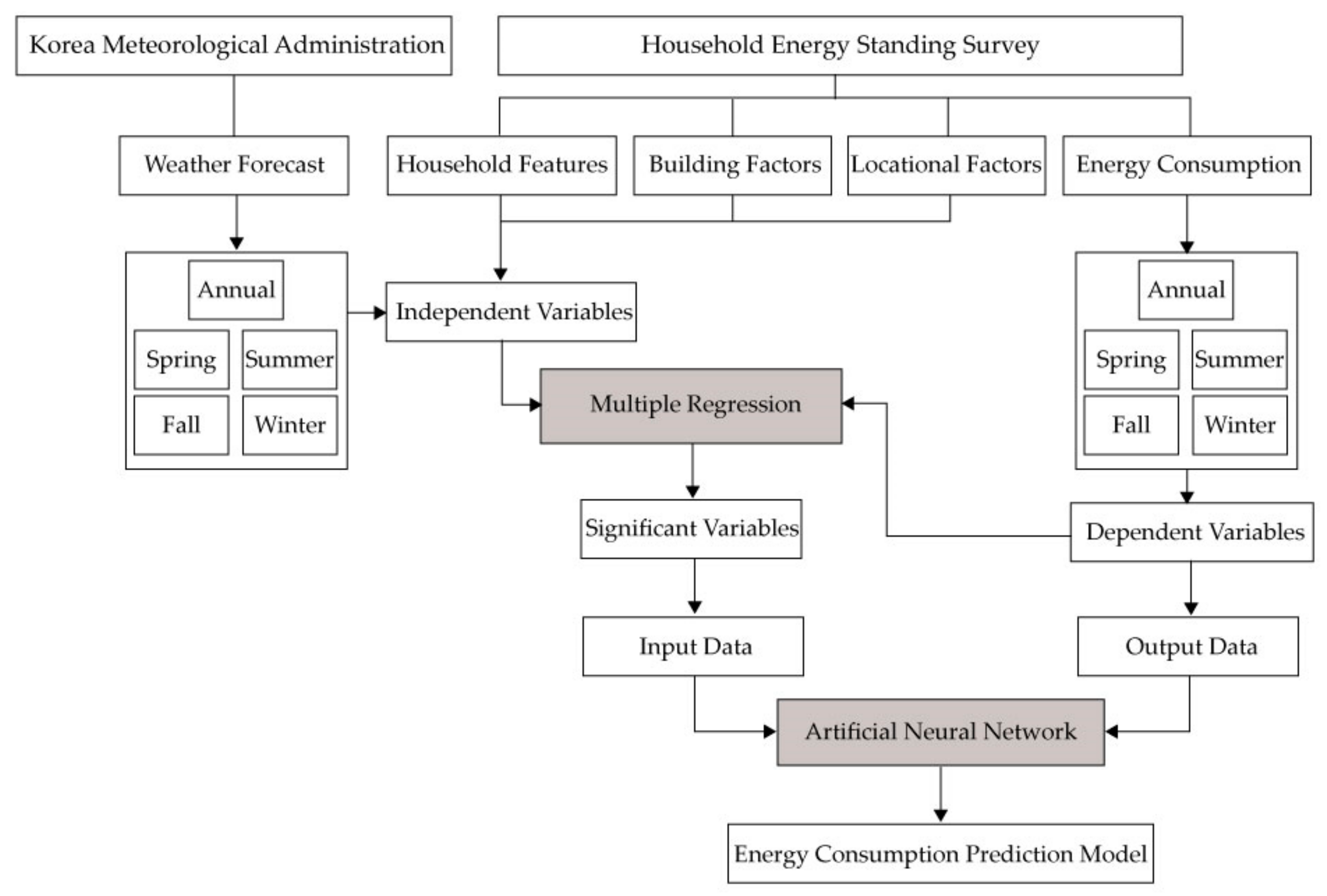
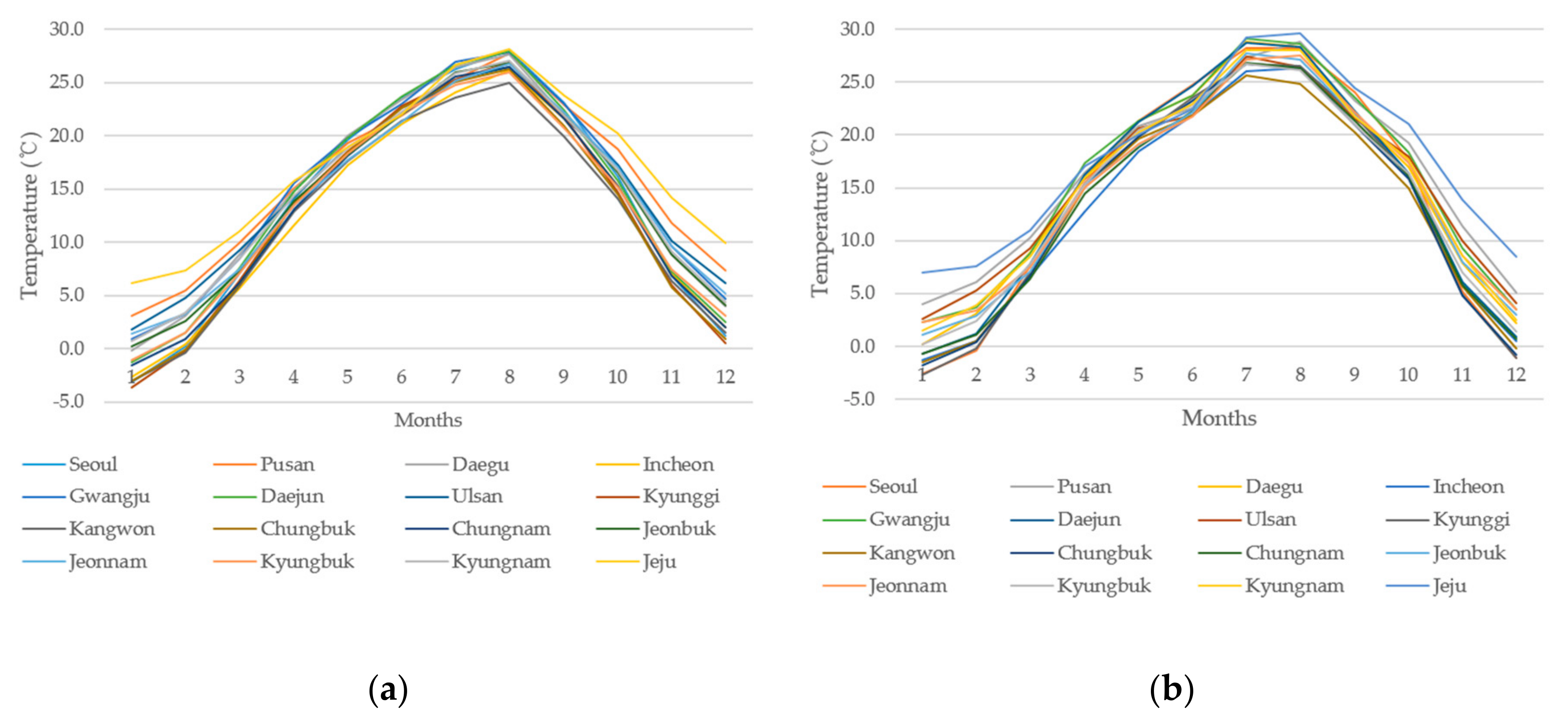
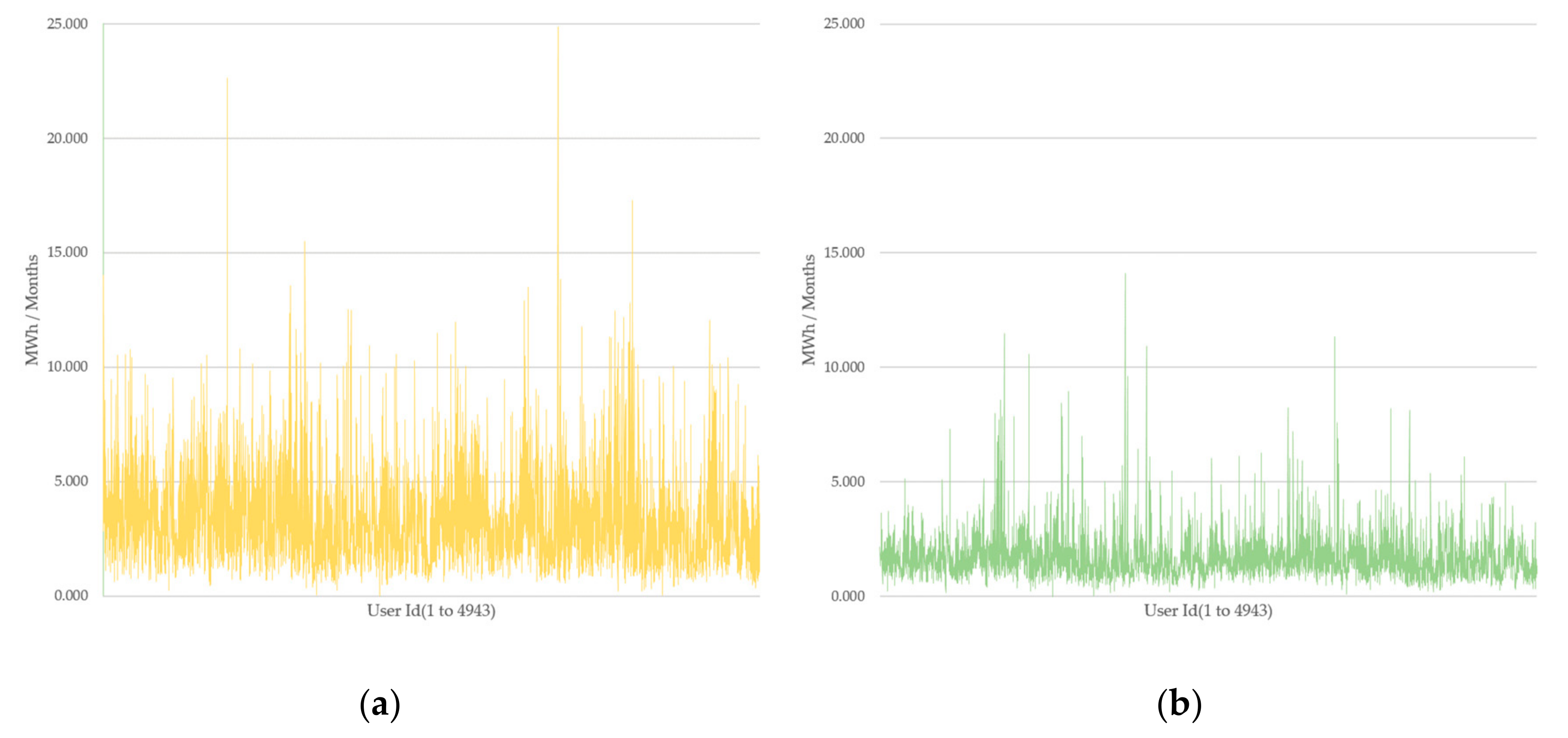
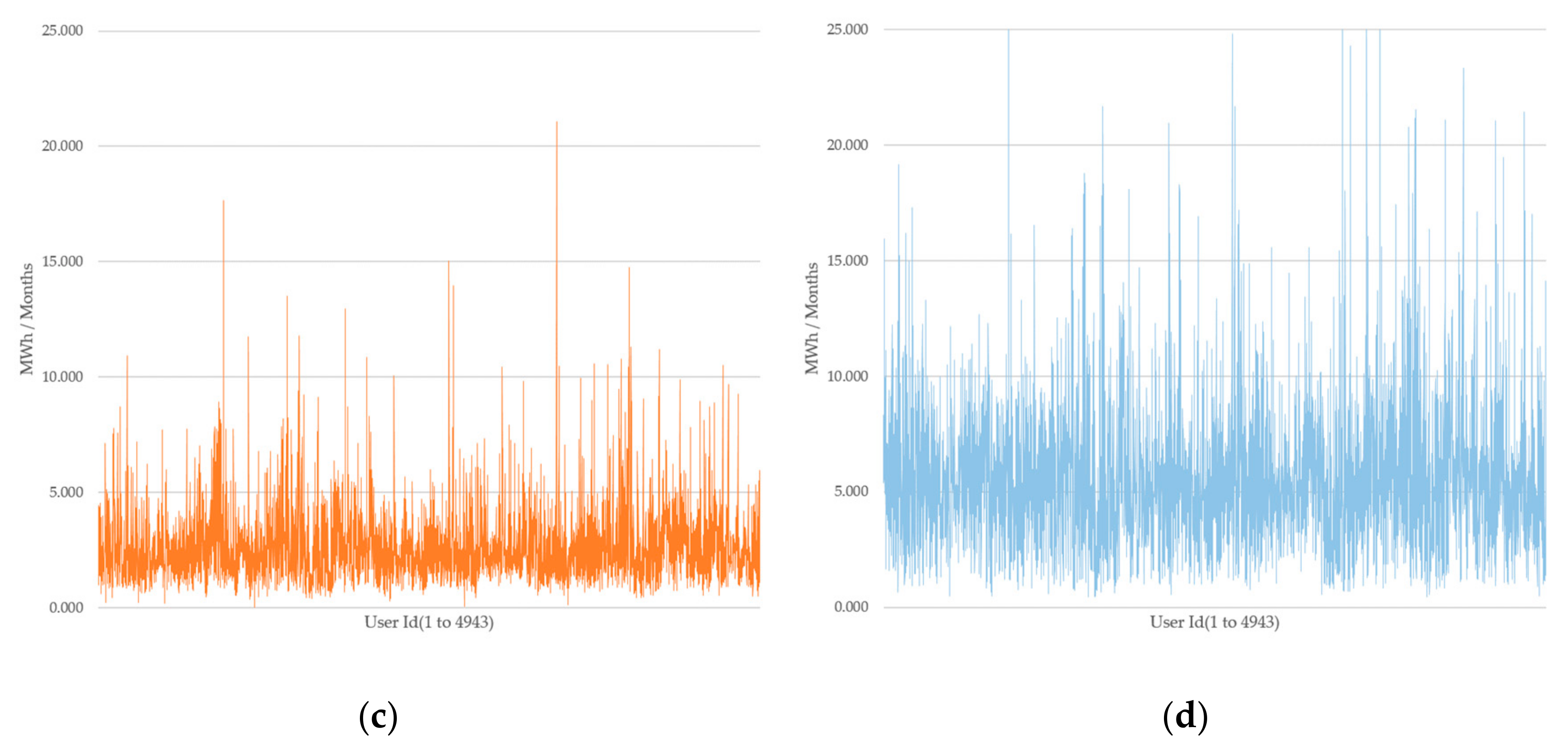
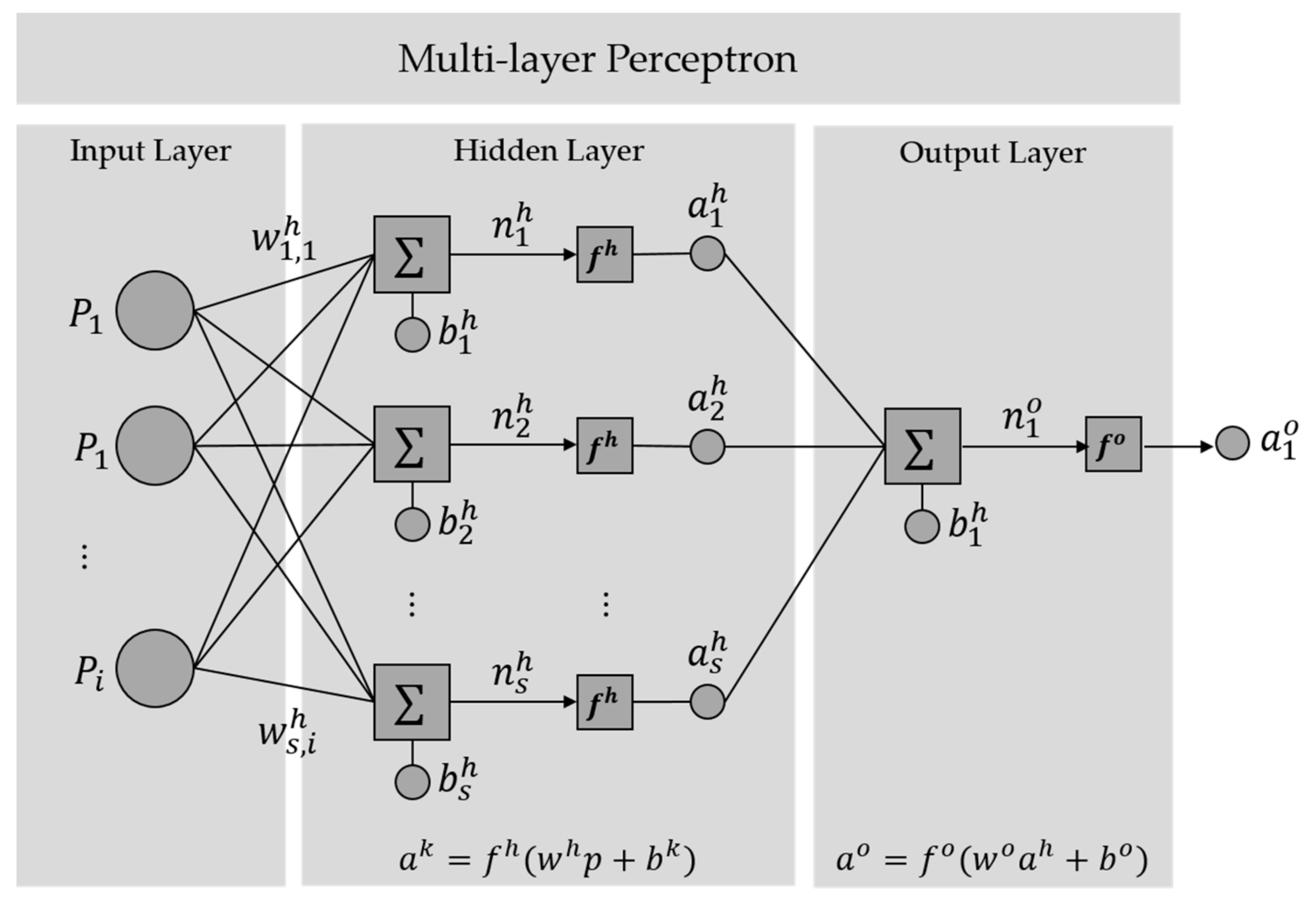
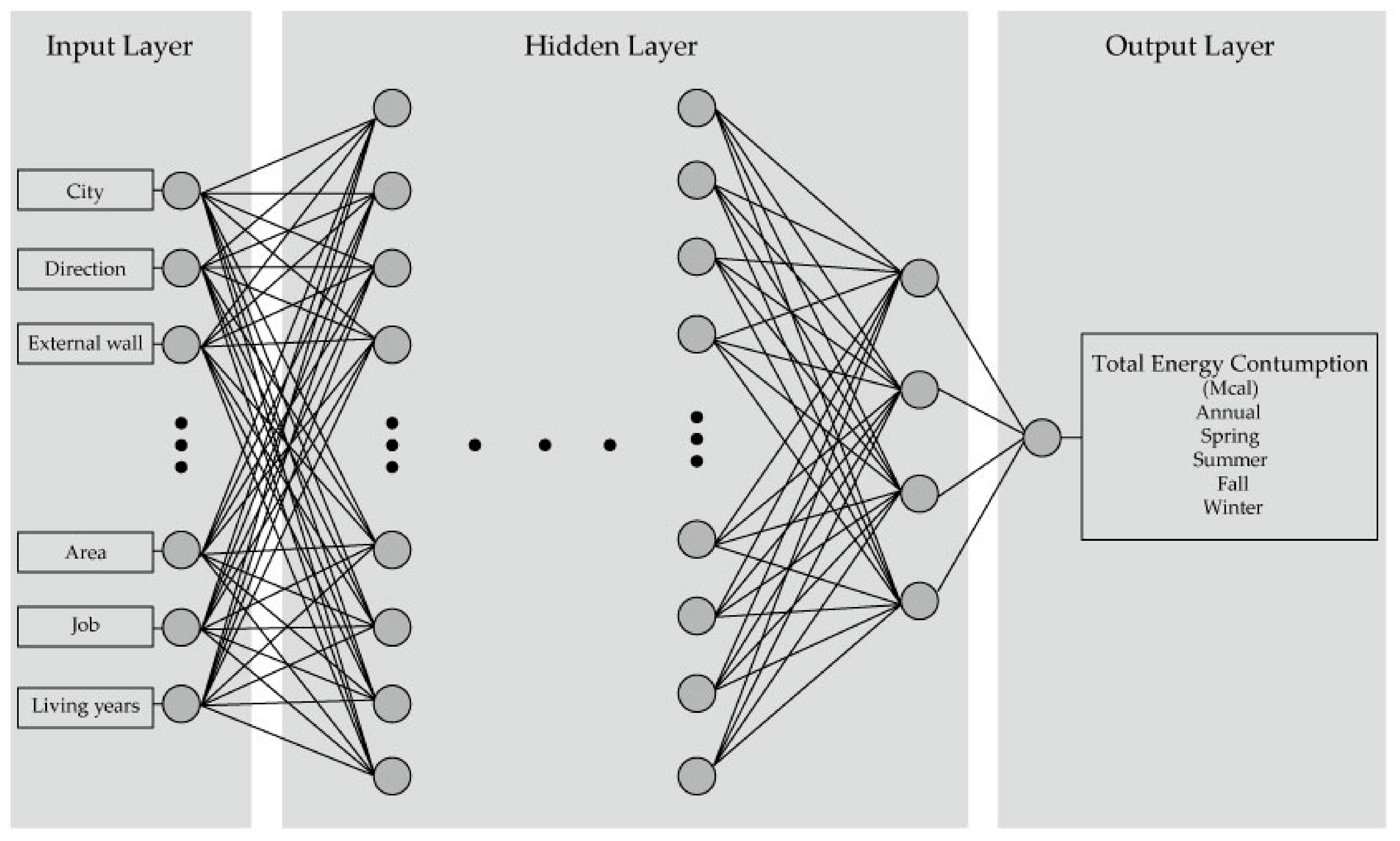
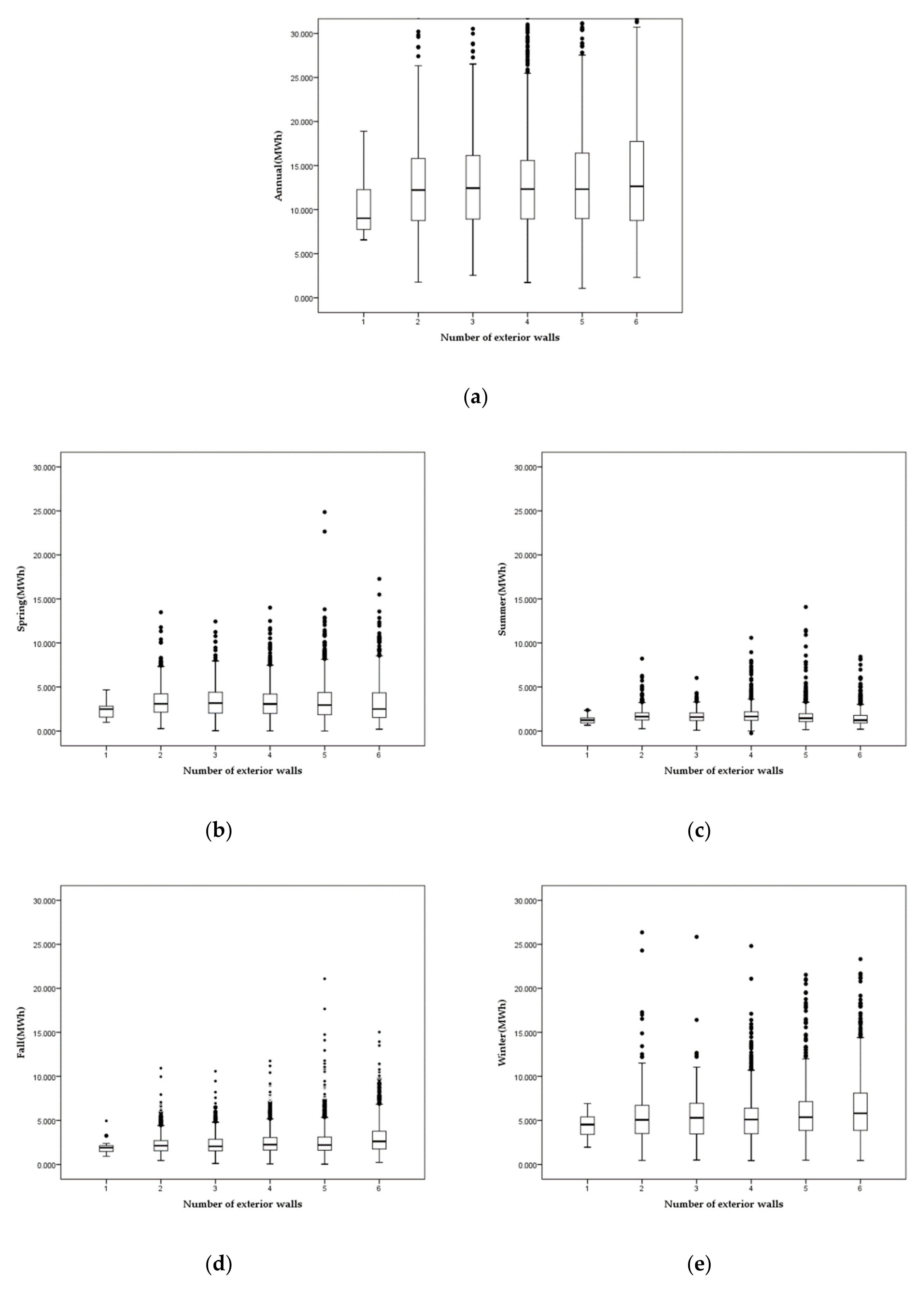
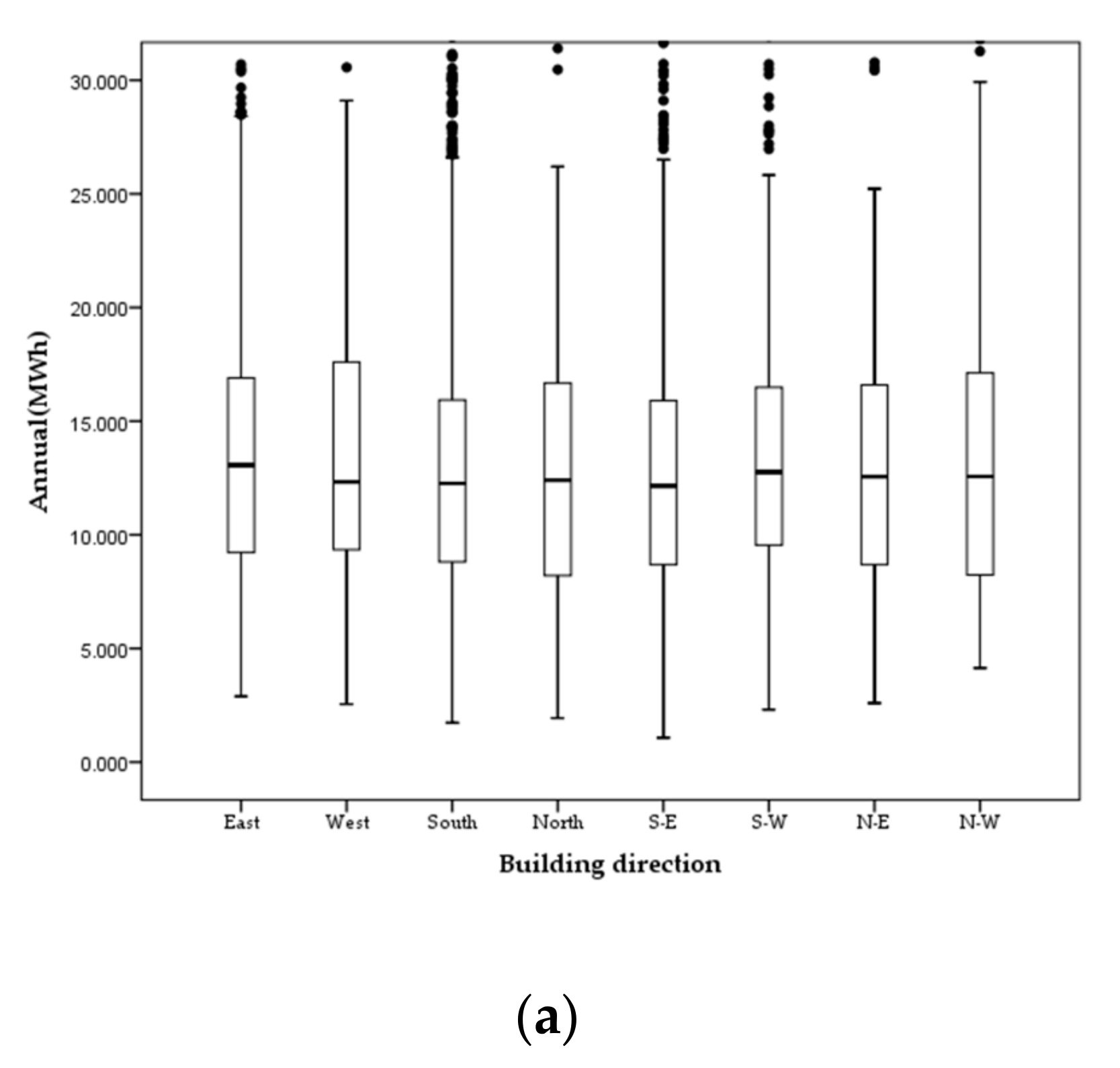
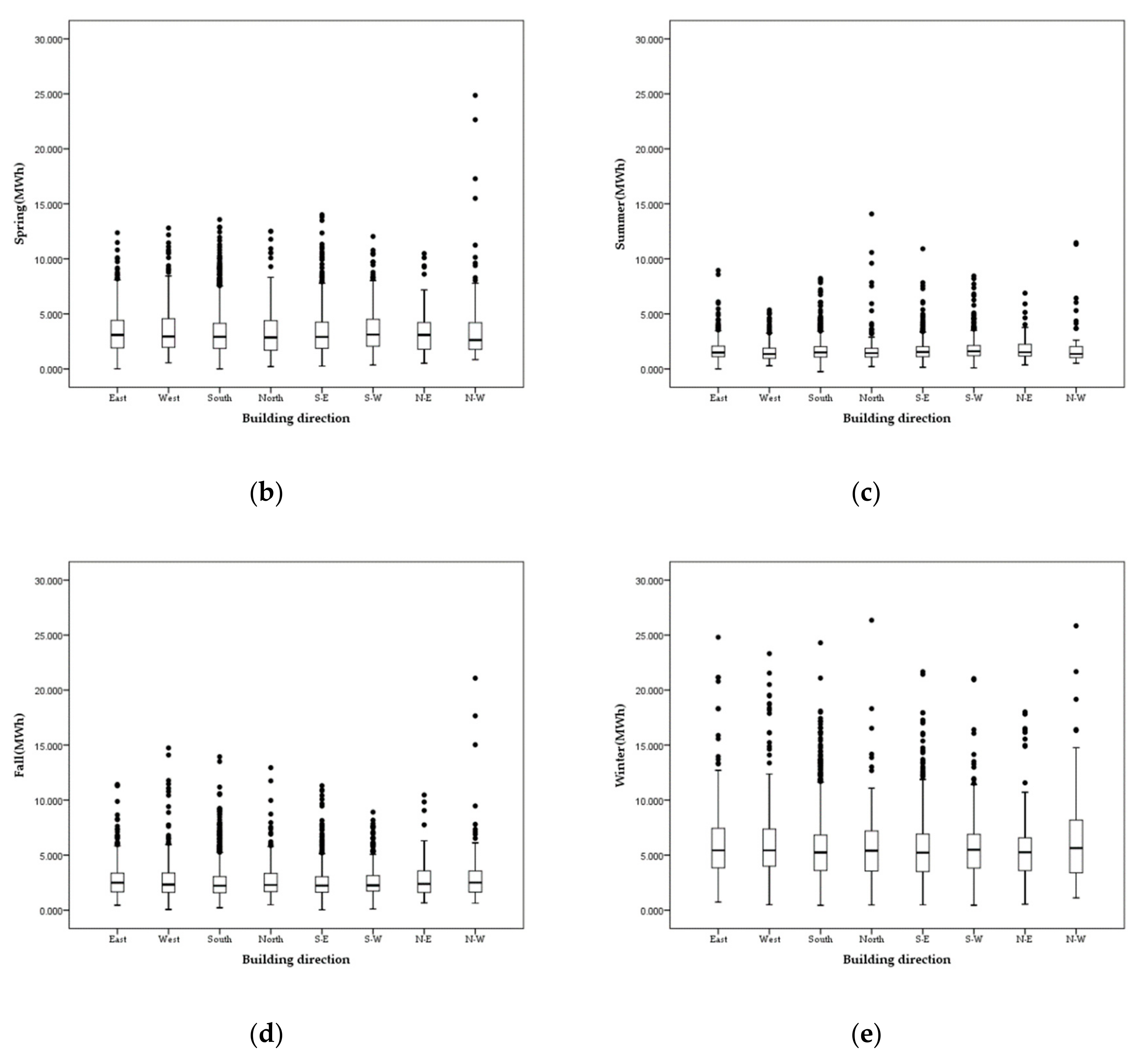

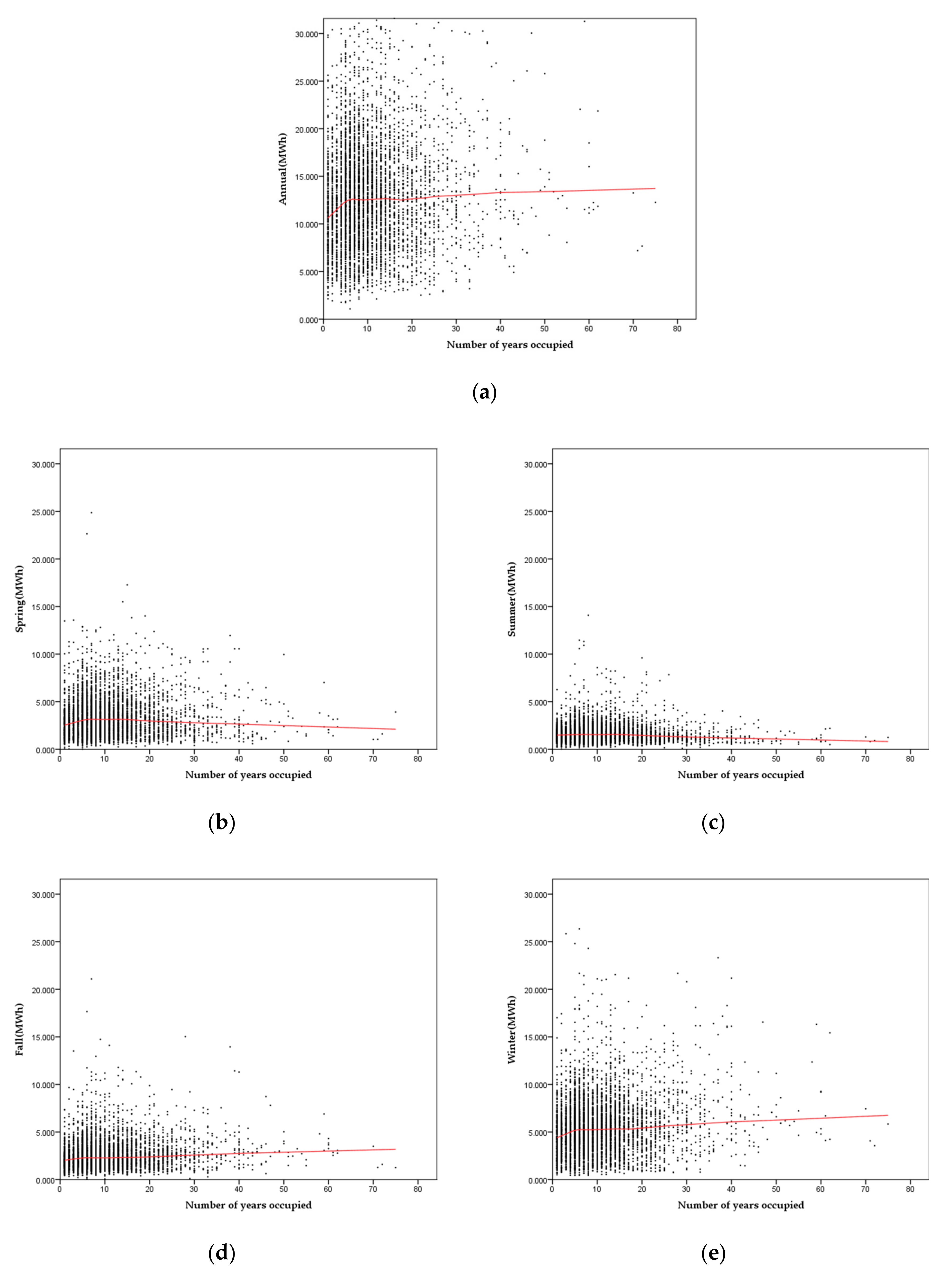
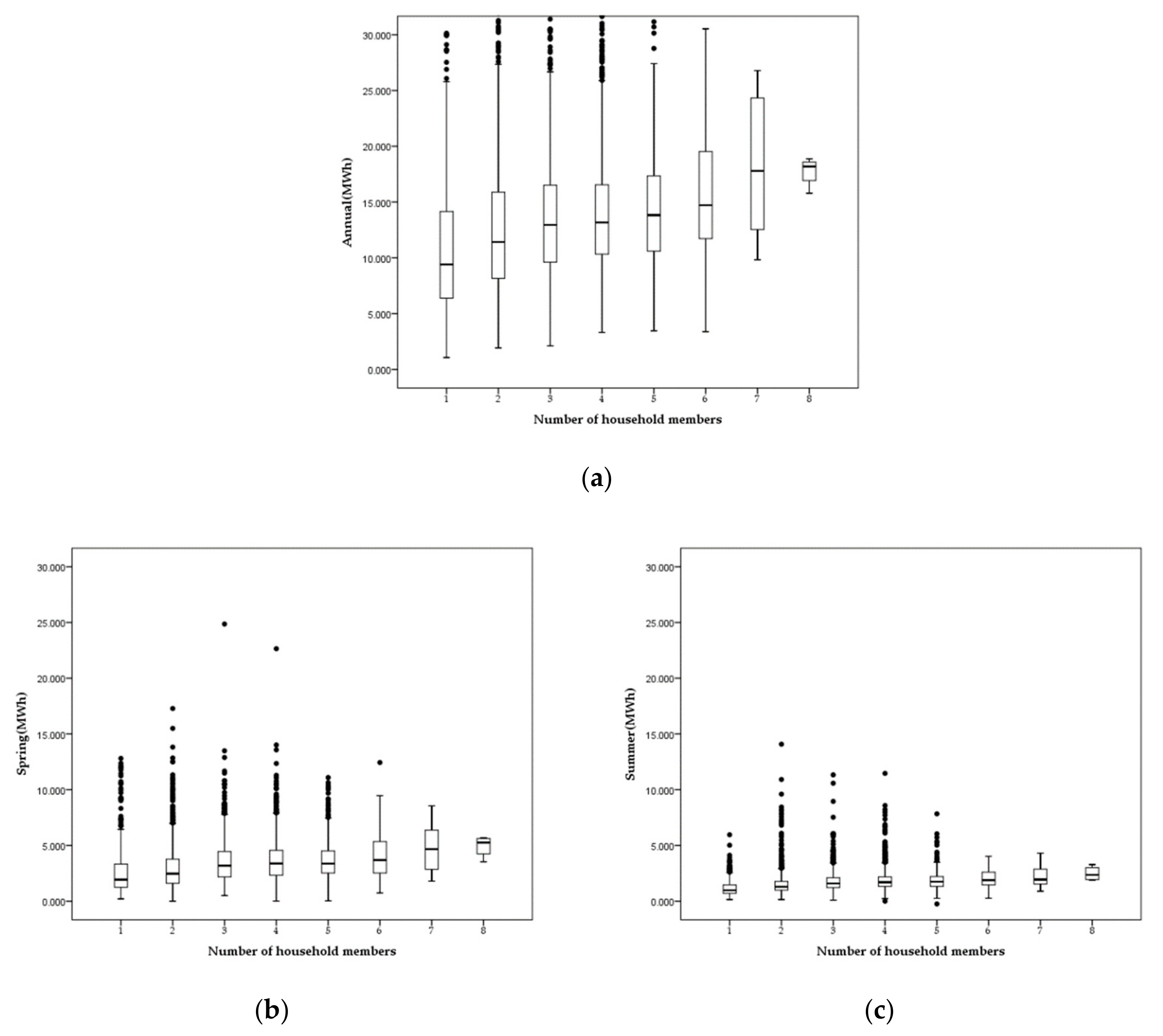
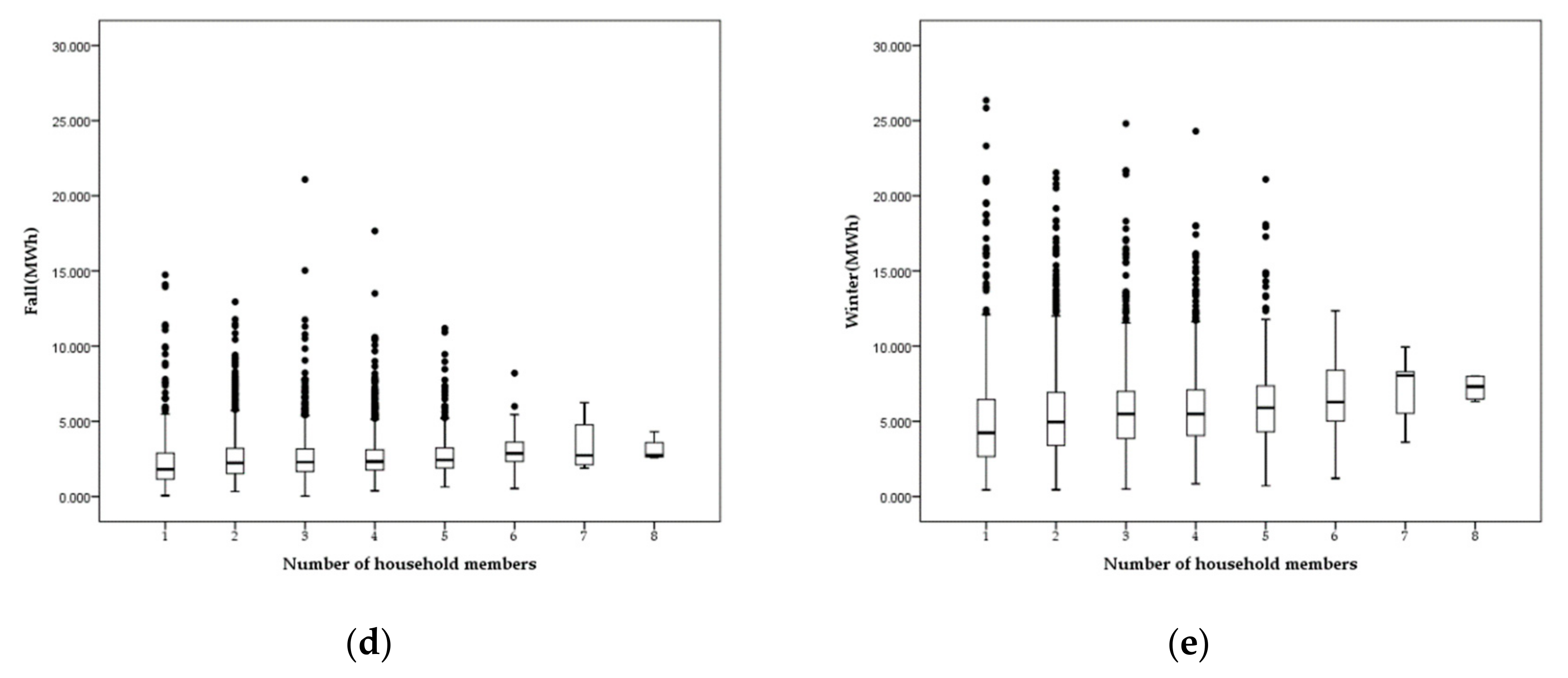
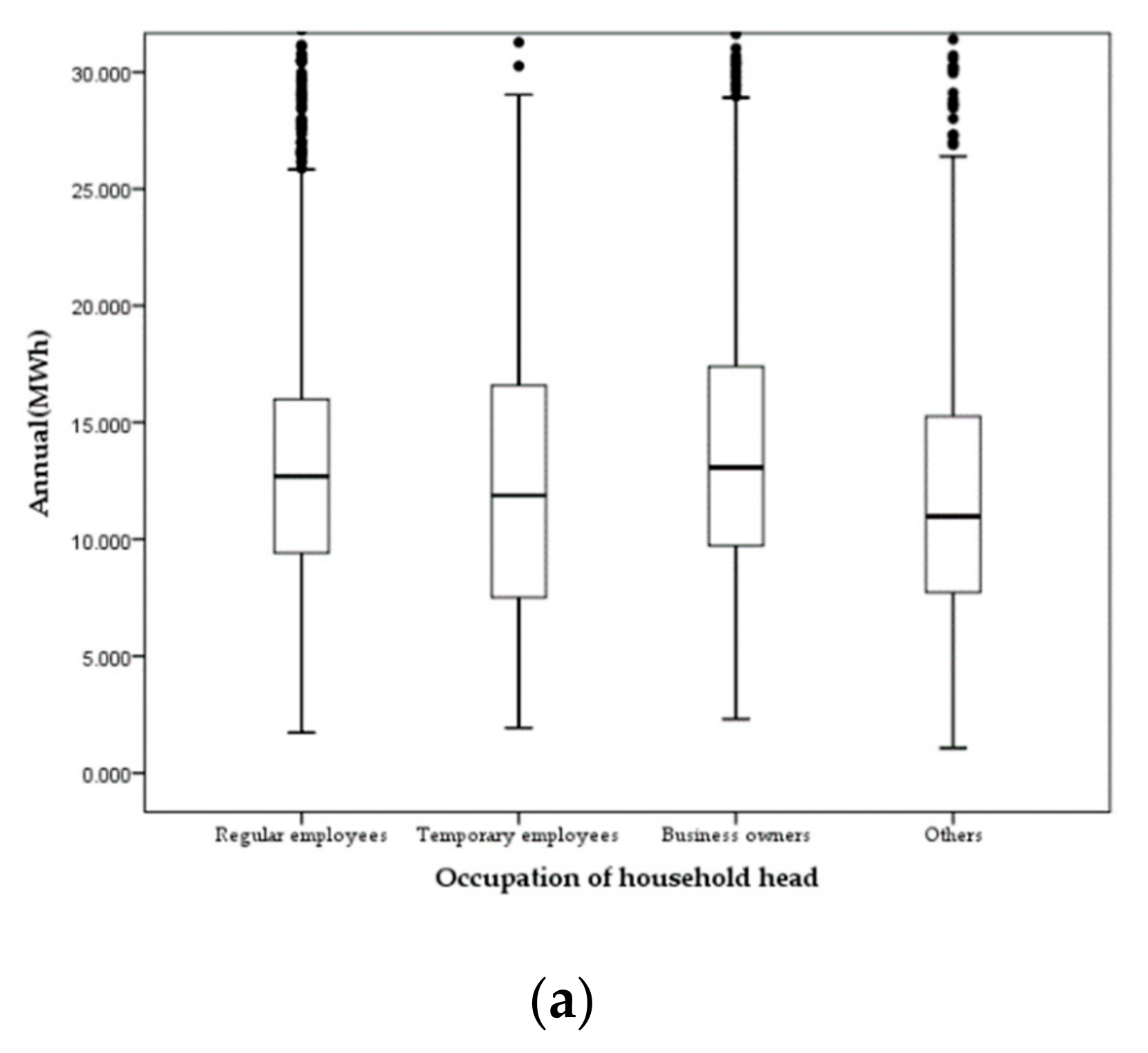
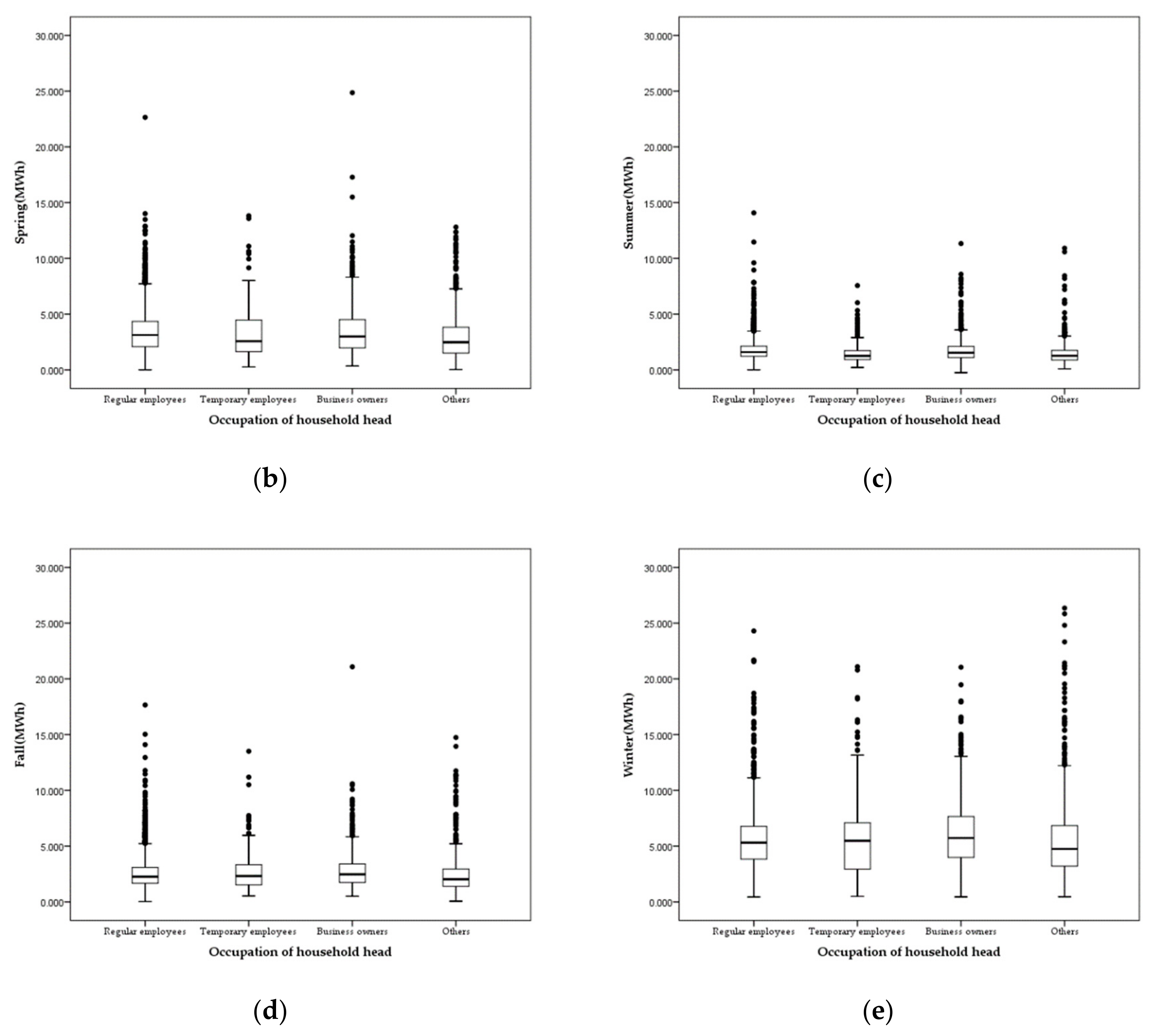
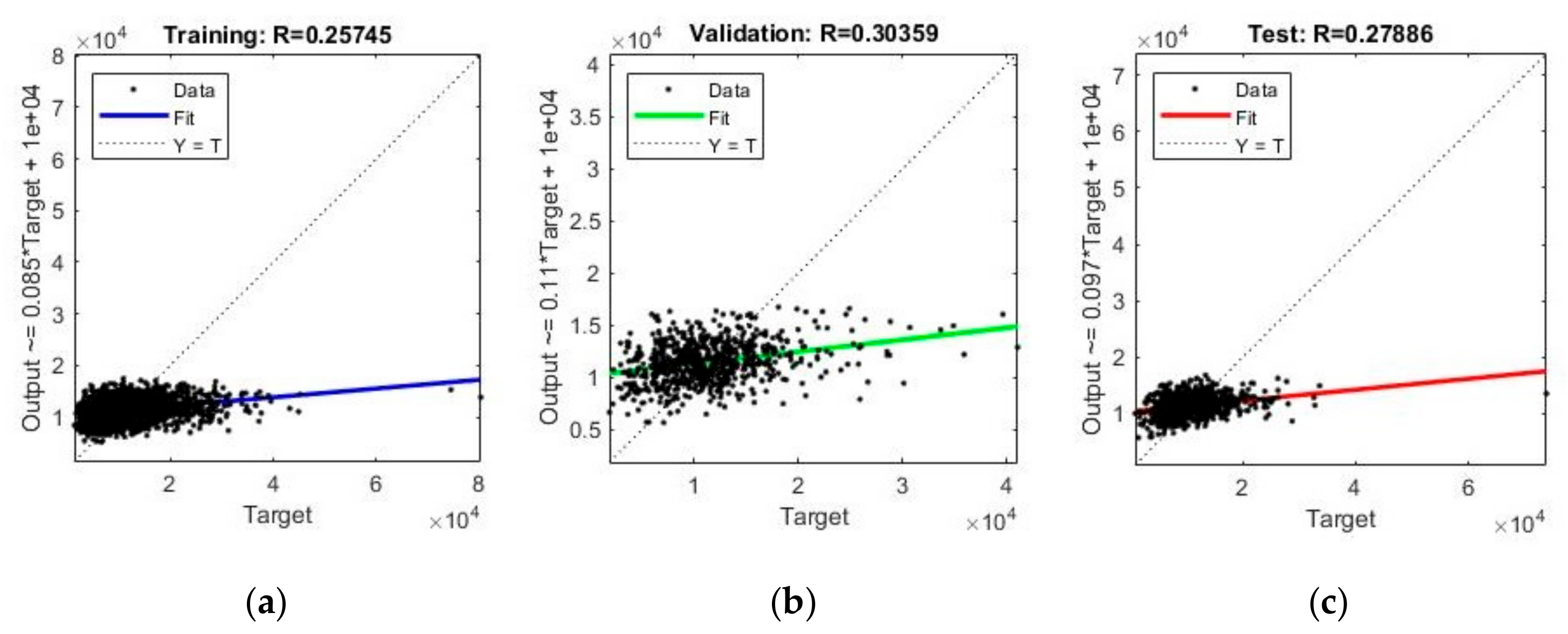
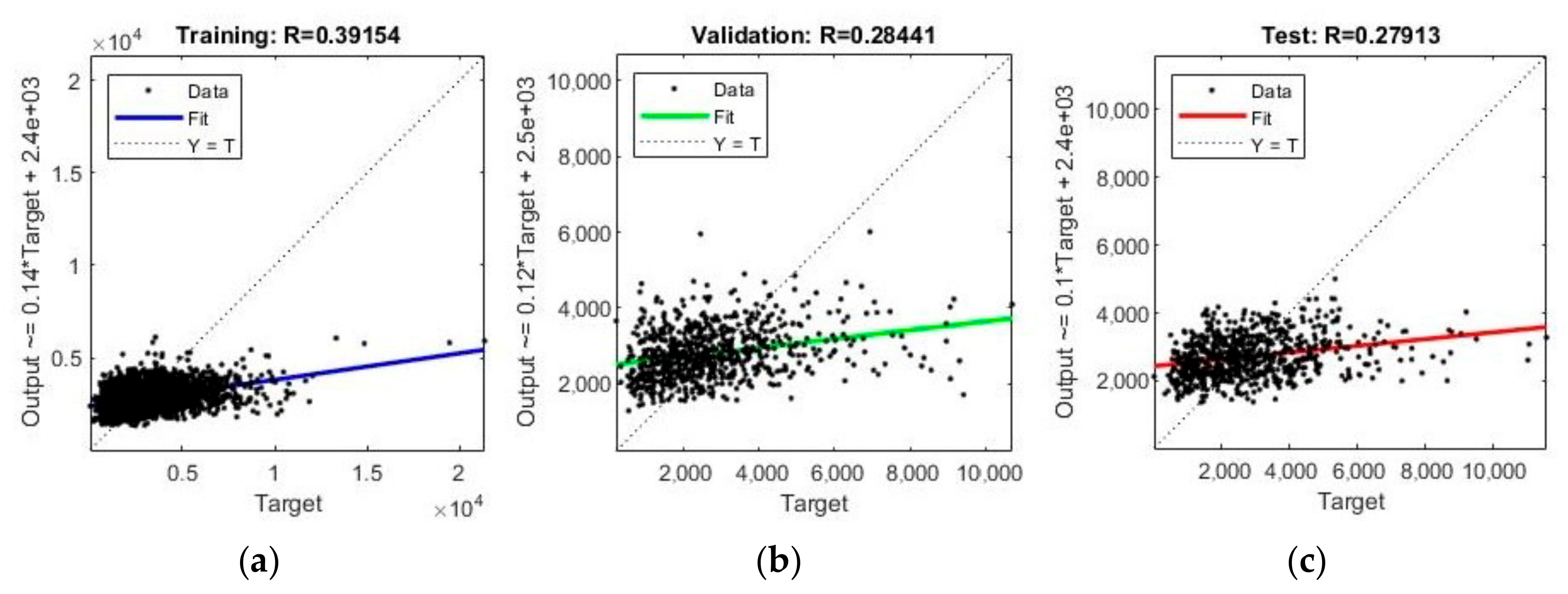
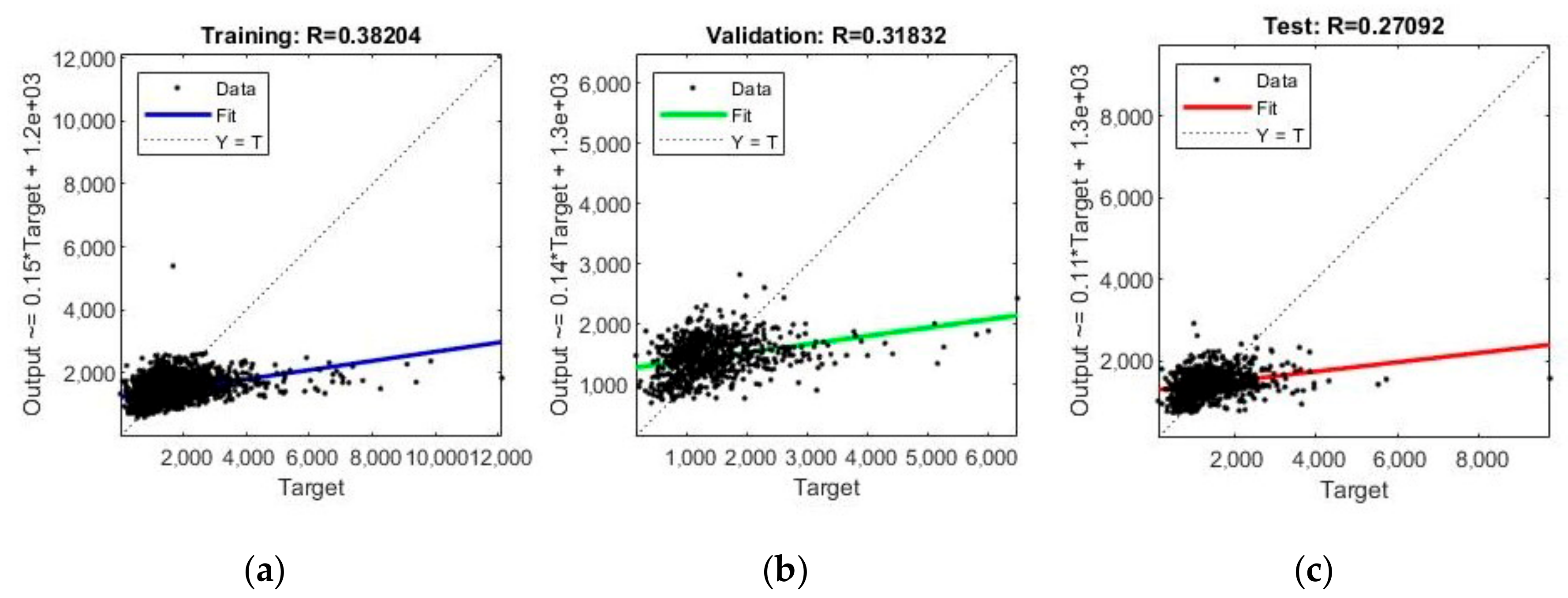
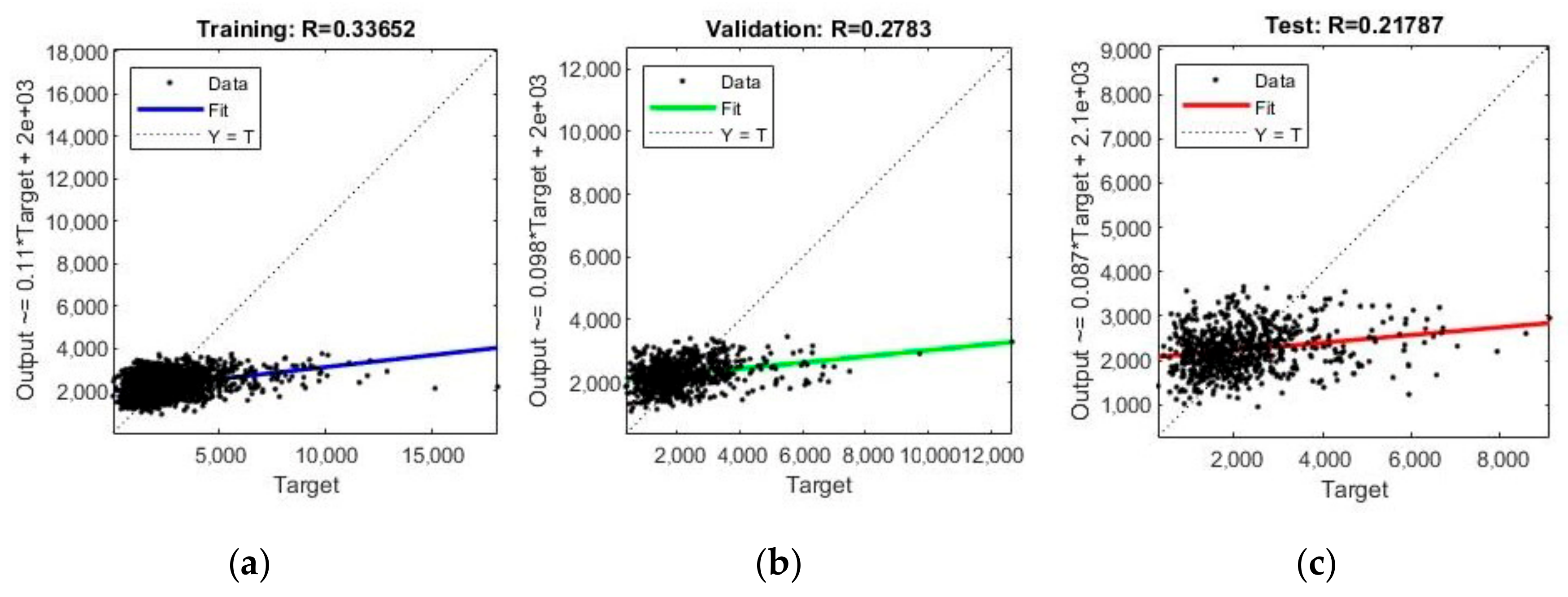
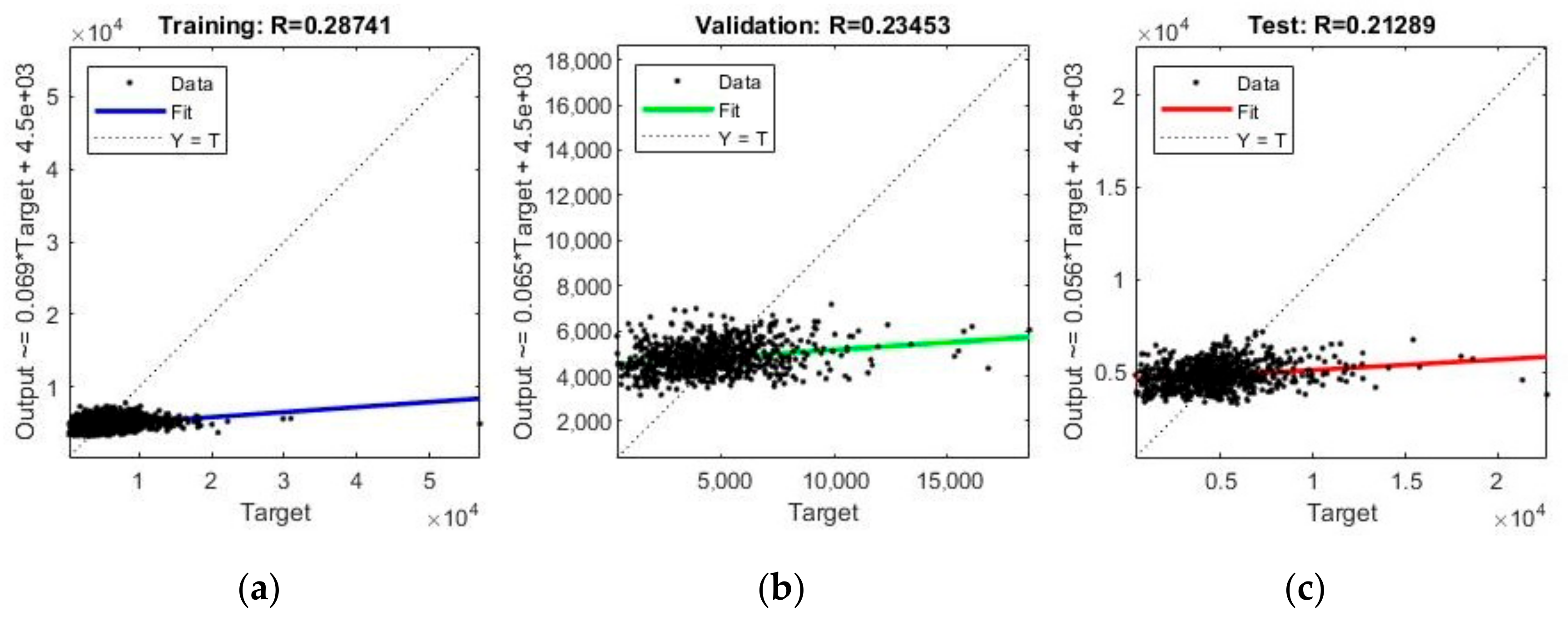
| Code | Variable | Category | Mean | Standard Deviation | N | Common Difference | VIF | |
|---|---|---|---|---|---|---|---|---|
| city | City | 11 | Seoul * | − | − | − | − | − |
| 21 | Pusan | 00.0647 | 0.24609 | 4943 | 0.703 | 1.423 | ||
| 22 | Daegu | 00.0475 | 0.21282 | 4943 | 0.778 | 1.285 | ||
| 23 | Incheon | 00.0477 | 0.21325 | 4943 | 0.774 | 1.292 | ||
| 24 | Gwangju | 00.0473 | 0.21239 | 4943 | 0.756 | 1.322 | ||
| 25 | Daejun | 00.0471 | 0.21195 | 4943 | 0.791 | 1.264 | ||
| 26 | Ulsan | 00.0324 | 0.17700 | 4943 | 0.818 | 1.222 | ||
| 31 | Kyunggi | 0.1107 | 0.31374 | 4943 | 0.628 | 1.593 | ||
| 32 | Kangwon | 00.0475 | 0.21282 | 4943 | 0.733 | 1.364 | ||
| 33 | Chungbuk | 00.0453 | 0.20802 | 4943 | 0.744 | 1.345 | ||
| 34 | Chungnam | 00.0637 | 0.24429 | 4943 | 0.667 | 1.500 | ||
| 35 | Jeonbuk | 00.0473 | 0.21239 | 4943 | 0.714 | 1.402 | ||
| 36 | Jeonnam | 00.0627 | 0.24247 | 4943 | 0.676 | 1.479 | ||
| 37 | Kyungbuk | 00.0803 | 0.27181 | 4943 | 0.636 | 1.573 | ||
| 38 | Kyungnam | 00.0807 | 0.27243 | 4943 | 0.626 | 1.598 | ||
| 39 | Jeju | 00.0152 | 0.12225 | 4943 | 0.879 | 1.137 | ||
| B_a1 | Housing type | 1 | Detached | 0.3862 | 0.48693 | 4943 | 0.400 | 2.500 |
| 2 | Apartment | 0.4574 | 0.49823 | 4943 | 0.226 | 4.433 | ||
| 3 | Others * | − | − | − | − | − | ||
| B_a2 | Number of floors | Numeric | 8.22 | 7.805 | 4943 | 0.182 | 5.485 | |
| B_a3 | Floor number | Numeric | 4.34 | 4.943 | 4943 | 0.443 | 2.258 | |
| B_a4 | Number of exterior walls | Numeric | 4.33 | 1.278 | 4943 | 0.582 | 1.718 | |
| B_a5 | Housing direction | 1 | East | 0.1194 | 0.32425 | 4943 | 0.303 | 3.305 |
| 2 | West | 00.0641 | 0.24501 | 4943 | 0.426 | 2.346 | ||
| 3 | South | 0.4200 | 0.49361 | 4943 | 0.162 | 6.189 | ||
| 4 | North * | − | − | − | − | − | ||
| 5 | Southeast | 0.1993 | 0.39949 | 4943 | 0.224 | 4.473 | ||
| 6 | Southwest | 0.1034 | 0.30448 | 4943 | 0.327 | 30.055 | ||
| 7 | Northeast | 00.0299 | 0.17044 | 4943 | 0.610 | 1.640 | ||
| 8 | Northwest | 00.0190 | 0.13660 | 4943 | 0.694 | 1.440 | ||
| B_a6 | Construction year | Numeric | 3.82 | 1.298 | 4943 | 0.597 | 1.674 | |
| B_a7 | Housing area | Numeric | 3.17 | 0.867 | 4943 | 0.411 | 2.432 | |
| B_a8 | Number of bedrooms (rooms) | Numeric | 2.72 | 0.728 | 4943 | 0.488 | 20.050 | |
| B_a9 | Number of exterior wall windows | Numeric | 8.11 | 3.961 | 4943 | 0.737 | 1.357 | |
| B_a10 | Main heating method | 1 | Individual | 0.9092 | 0.28740 | 4943 | 0.785 | 1.274 |
| 2 | Central heating * | − | − | − | − | − | ||
| B_a11 | Cooling method | 1 | Air conditioner | 0.3045 | 0.46023 | 4943 | 0.180 | 5.558 |
| 2 | No air conditioner * | − | − | − | − | − | ||
| B_a12 | Air conditioner set temperature | Numeric | 3.13 | 20.049 | 4943 | 0.160 | 6.239 | |
| H_a1 | Number of years occupied | Numeric | 10.91 | 8.722 | 4943 | 0.154 | 6.513 | |
| H_a2 | Housing ownership | 1 | Owned | 0.7589 | 0.42782 | 4943 | 0.827 | 1.209 |
| 2 | Not owned * | − | − | − | − | − | ||
| H_a3 | Number of household members | Numeric | 2.97 | 1.242 | 4943 | 0.487 | 20.054 | |
| H_a4 | Number of economically active household members | Numeric | 1.45 | 0.767 | 4943 | 0.622 | 1.608 | |
| H_a5 | Number of household members aged 65 or older | Numeric | 0.47 | 0.743 | 4943 | 0.557 | 1.795 | |
| H_a6 | Composition of household members | 1 | Children | 00.0500 | 0.21790 | 4943 | 0.756 | 1.322 |
| 2 | No children * | − | − | − | − | − | ||
| H_a7 | Gender of household head | 1 | Male | 0.7499 | 0.43309 | 4943 | 0.742 | 1.348 |
| 2 | Female * | − | − | − | − | − | ||
| H_a8 | Age of household head | Numeric | 3.74 | 10.052 | 4943 | 0.486 | 20.056 | |
| H_a9 | Education level of household head | 1 | High school graduate or below | 0.5855 | 0.49269 | 4943 | 0.624 | 1.602 |
| 2 | University graduate or above * | − | − | − | − | − | ||
| H_a10 | Occupation of household head | 1 | Regular employee | 0.4965 | 0.50004 | 4943 | 0.360 | 2.775 |
| 2 | Temporary employee | 00.0558 | 0.22963 | 4943 | 0.770 | 1.298 | ||
| 3 | Owner operator | 0.2320 | 0.42218 | 4943 | 0.459 | 2.179 | ||
| 4 | Etc. | − | − | − | − | − | ||
| H_a11 | Unusual features of household | 1 | Unusual features | 00.0981 | 0.29750 | 4943 | 0.633 | 1.579 |
| 2 | General * | − | − | − | − | − | ||
| H_a12 | Annual gross income | Numeric | 3.67 | 1.862 | 4943 | 0.426 | 2.347 | |
| R | R2 | Revised R2 | Estimated Standard Error | Durbin–Watson | F | Significant Probability | |
|---|---|---|---|---|---|---|---|
| Annual | 0.346 | 0.120 | 0.111 | 5284.355 | 1.664 | 130.084 | 00.000 |
| Spring | 0.354 | 0.125 | 0.116 | 1643.510 | 1.674 | 140.031 | 00.000 |
| Summer | 0.377 | 0.142 | 0.134 | 7740.096 | 1.749 | 16.251 | 00.000 |
| Fall | 0.332 | 0.110 | 0.101 | 1263.190 | 1.661 | 120.081 | 00.000 |
| Winter | 0.351 | 0.123 | 0.114 | 25,570.053 | 1.674 | 13.778 | 00.000 |
| Section | Code | Variable | Spring | Summer | Fall | Winter | Annual |
|---|---|---|---|---|---|---|---|
| Temp | Temperature | O | O | ||||
| city | City | O | O | O | O | O | |
| Building factors (12) | B_a1 | Housing type | O | O | O | O | |
| B_a2 | Number of floors | O | |||||
| B_a3 | Floor number | ||||||
| B_a4 | Number of exterior walls | O | O | O | O | O | |
| B_a5 | Housing direction | O | O | O | O | O | |
| B_a6 | Construction year | O | O | O | O | ||
| B_a7 | Housing area | O | O | O | O | O | |
| B_a8 | Number of bedrooms (rooms) | O | |||||
| B_a9 | Number of exterior wall windows | O | O | ||||
| B_a10 | Main heating method | O | O | O | |||
| B_a11 | Cooling method | O | O | O | |||
| B_a12 | Air conditioner set temperature | O | O | ||||
| User features (12) | H_a1 | Number of years occupied | O | O | O | O | O |
| H_a2 | Housing ownership | ||||||
| H_a3 | Number of household members | O | O | O | O | O | |
| H_a4 | Number of economically active household members | ||||||
| H_a5 | Number of household members aged 65 or older | O | |||||
| H_a6 | Composition of household members | O | |||||
| H_a7 | Gender | O | O | O | |||
| H_a8 | Age of household head | O | |||||
| H_a9 | Education level of household head | O | |||||
| H_a10 | Occupation of household head | O | O | O | O | O | |
| H_a11 | Unusual features of household | O | O | ||||
| H_a12 | Annual gross income | O | O | O | O | ||
| Total | 11 | 15 | 15 | 17 | 12 | ||
| No. of Samples | Training | Validation | Testing |
|---|---|---|---|
| 4943 | 70% | 15% | 15% |
| 3461 | 741 | 741 |
| Period | Min | Max | Layer | Neuron | R Value of Training | R Value of Validation | R Value of Test | MSE | Terminated Epoch |
|---|---|---|---|---|---|---|---|---|---|
| Annual | 42 | 85 | 1 | 70 | 0.257 | 0.303 | 0.278 | × 2.5250 | 12th |
| 2 | 35 | 0.351 | 0.279 | 0.306 | × 2.7545 | 5th | |||
| 3 | 21 | 0.419 | 0.299 | 0.312 | × 3.4674 | 5th | |||
| 4 | 11 | 0.361 | 0.288 | 0.262 | × 2.6649 | 4th | |||
| 5 | 13 | 0.427 | 0.270 | 0.272 | × 2.8077 | 7th | |||
| 6 | 14 | 0.535 | 0.348 | 0.256 | × 3.1436 | 12th | |||
| Spring | 38 | 77 | 1 | 47 | 0.363 | 0.296 | 0.235 | × 2.6339 | 14th |
| 2 | 24 | 0.391 | 0.284 | 0.279 | × 2.5981 | 5th | |||
| 5 | 8 | 0.477 | 0.312 | 0.246 | × 2.7300 | 7th | |||
| 6 | 12 | 0.457 | 0.256 | 0.331 | × 2.7304 | 4th | |||
| 7 | 6 | 0.376 | 0.283 | 0.324 | × 2.7068 | 8th | |||
| 8 | 7 | 0.404 | 0.278 | 0.317 | × 2.6193 | 9th | |||
| Summer | 46 | 93 | 1 | 58 | 0.322 | 0.315 | 0.283 | × 5.3157 | 12th |
| 2 | 23 | 0.543 | 0.264 | 0.243 | × 7.9380 | 5th | |||
| 3 | 16 | 0.382 | 0.318 | 0.270 | × 5.1060 | 7th | |||
| 4 | 17 | 0.382 | 0.247 | 0.213 | × 6.1292 | 2nd | |||
| 5 | 10 | 0.450 | 0.389 | 0.353 | × 5.4341 | 8th | |||
| 6 | 8 | 0.442 | 0.342 | 0.372 | × 5.9818 | 6th | |||
| Fall | 47 | 95 | 1 | 47 | 0.336 | 0.278 | 0.217 | × 1.4318 | 27th |
| 2 | 30 | 0.152 | 0.158 | 0.131 | × 1.6054 | 19th | |||
| 3 | 16 | 0.399 | 0.273 | 0.201 | × 1.6571 | 3rd | |||
| 4 | 17 | 0.288 | 0.208 | 0.167 | × 1.8019 | 3rd | |||
| 5 | 10 | 0.423 | 0.248 | 0.293 | × 1.6133 | 4th | |||
| 6 | 15 | 0.565 | 0.244 | 0.316 | × 1.8063 | 7th | |||
| Winter | 48 | 97 | 1 | 84 | 0.336 | 0.287 | 0.261 | × 6.1731 | 15th |
| 2 | 24 | 0.287 | 0.234 | 0.212 | × 5.7602 | 8th | |||
| 3 | 24 | 0.732 | 0.359 | 0.336 | × 5.9531 | 2nd | |||
| 4 | 18 | 0.425 | 0.293 | 0.256 | × 5.9060 | 11th | |||
| 6 | 16 | 0.402 | 0.182 | 0.241 | × 7.2293 | 3rd | |||
| 7 | 13 | 0.485 | 0.252 | 0.293 | × 6.3134 | 4th |
| Period | Input Type | Layer | Neuron | R Value of Training | R Value of Validation | R Value of Test | MSE | Terminated Epoch |
|---|---|---|---|---|---|---|---|---|
| Annual | A | 1 | 70 | 0.257 | 0.303 | 0.278 | × 2.5250 | 12th |
| B | 1 | 70 | 0.327 | 0.238 | 0.262 | × 3.160 | 17th | |
| C | 1 | 70 | 0.320 | 0.215 | 0.270 | × 4024 | 24th | |
| Spring | A | 2 | 24 | 0.391 | 0.284 | 0.279 | × 2.5981 | 5th |
| B | 2 | 24 | − | − | − | − | − | |
| C | 2 | 24 | 0.724 | 0.363 | 0.297 | × 3.2416 | 9th | |
| Summer | A | 3 | 16 | 0.382 | 0.318 | 0.270 | x 5.1060 | 7th |
| B | 3 | 16 | − | − | − | − | − | |
| C | 3 | 16 | 0.629 | 0.279 | 0.339 | × 7.6997 | 6th | |
| Fall | A | 1 | 47 | 0.336 | 0.278 | 0.217 | × 1.4318 | 27th |
| B | 1 | 47 | 0.260 | 0.168 | 0.297 | × 1.5061 | 15th | |
| C | 1 | 47 | 0.374 | 0.326 | 0.245 | × 1.6476 | 15th | |
| Winter | A | 2 | 24 | 0.287 | 0.234 | 0.212 | × 5.7602 | 8th |
| B | 2 | 24 | 0.588 | 0.375 | 0.220 | × 6.4005 | 4th | |
| C | 2 | 24 | 0.477 | 0.287 | 0.318 | × 6.3853 | 6th |
© 2019 by the authors. Licensee MDPI, Basel, Switzerland. This article is an open access article distributed under the terms and conditions of the Creative Commons Attribution (CC BY) license (http://creativecommons.org/licenses/by/4.0/).
Share and Cite
Kim, M.; Jung, S.; Kang, J.-w. Artificial Neural Network-Based Residential Energy Consumption Prediction Models Considering Residential Building Information and User Features in South Korea. Sustainability 2020, 12, 109. https://doi.org/10.3390/su12010109
Kim M, Jung S, Kang J-w. Artificial Neural Network-Based Residential Energy Consumption Prediction Models Considering Residential Building Information and User Features in South Korea. Sustainability. 2020; 12(1):109. https://doi.org/10.3390/su12010109
Chicago/Turabian StyleKim, Mansu, Sungwon Jung, and Joo-won Kang. 2020. "Artificial Neural Network-Based Residential Energy Consumption Prediction Models Considering Residential Building Information and User Features in South Korea" Sustainability 12, no. 1: 109. https://doi.org/10.3390/su12010109
APA StyleKim, M., Jung, S., & Kang, J.-w. (2020). Artificial Neural Network-Based Residential Energy Consumption Prediction Models Considering Residential Building Information and User Features in South Korea. Sustainability, 12(1), 109. https://doi.org/10.3390/su12010109




